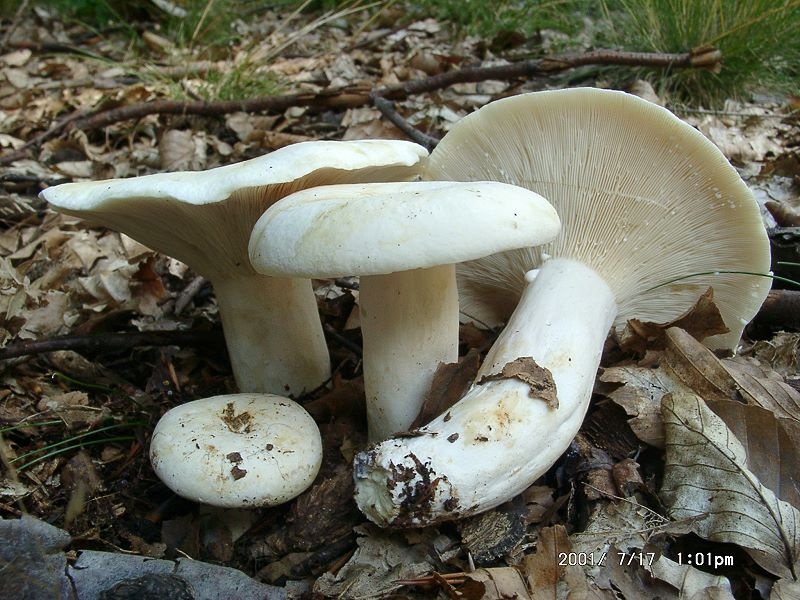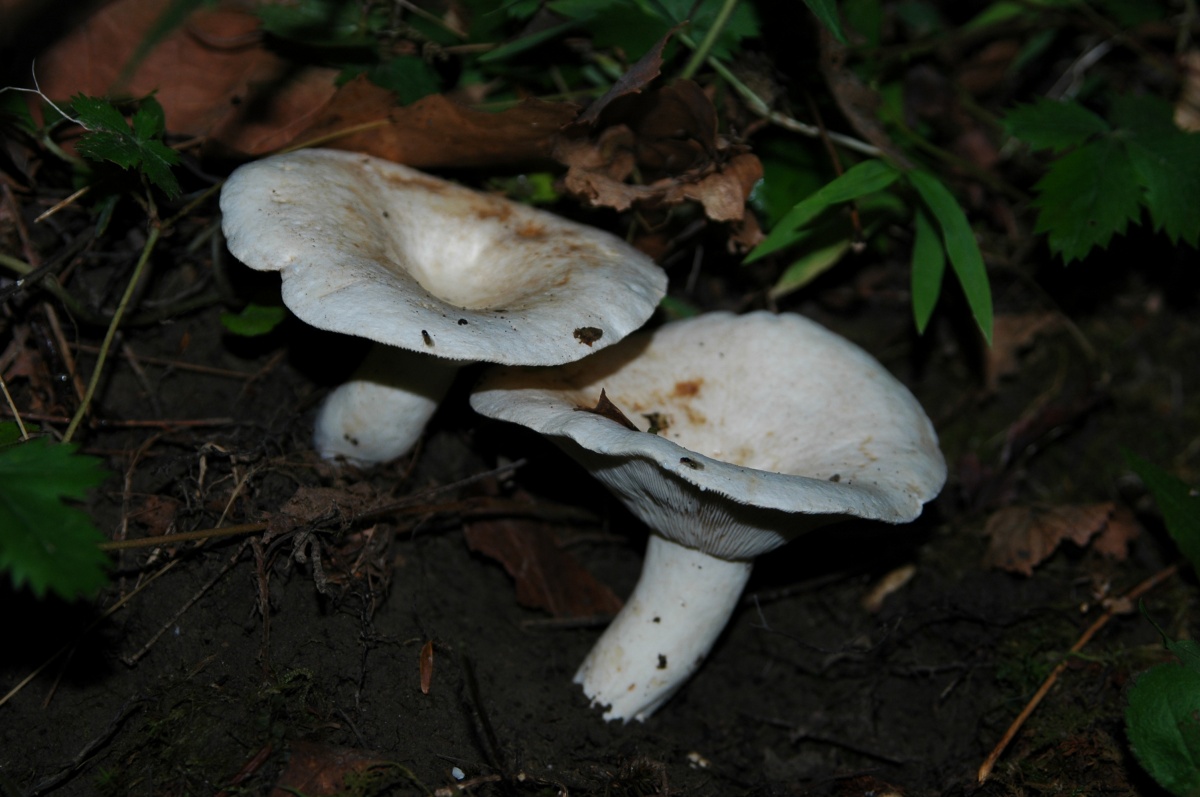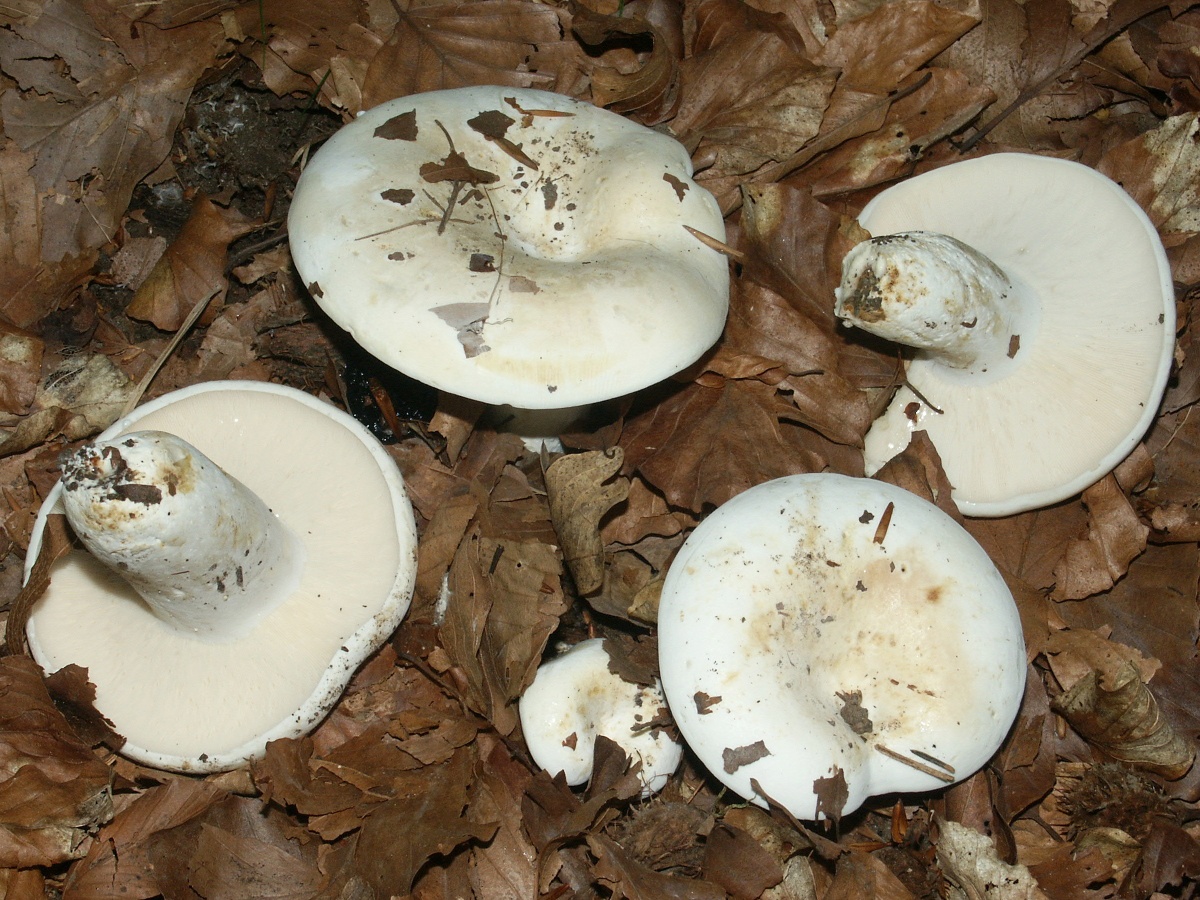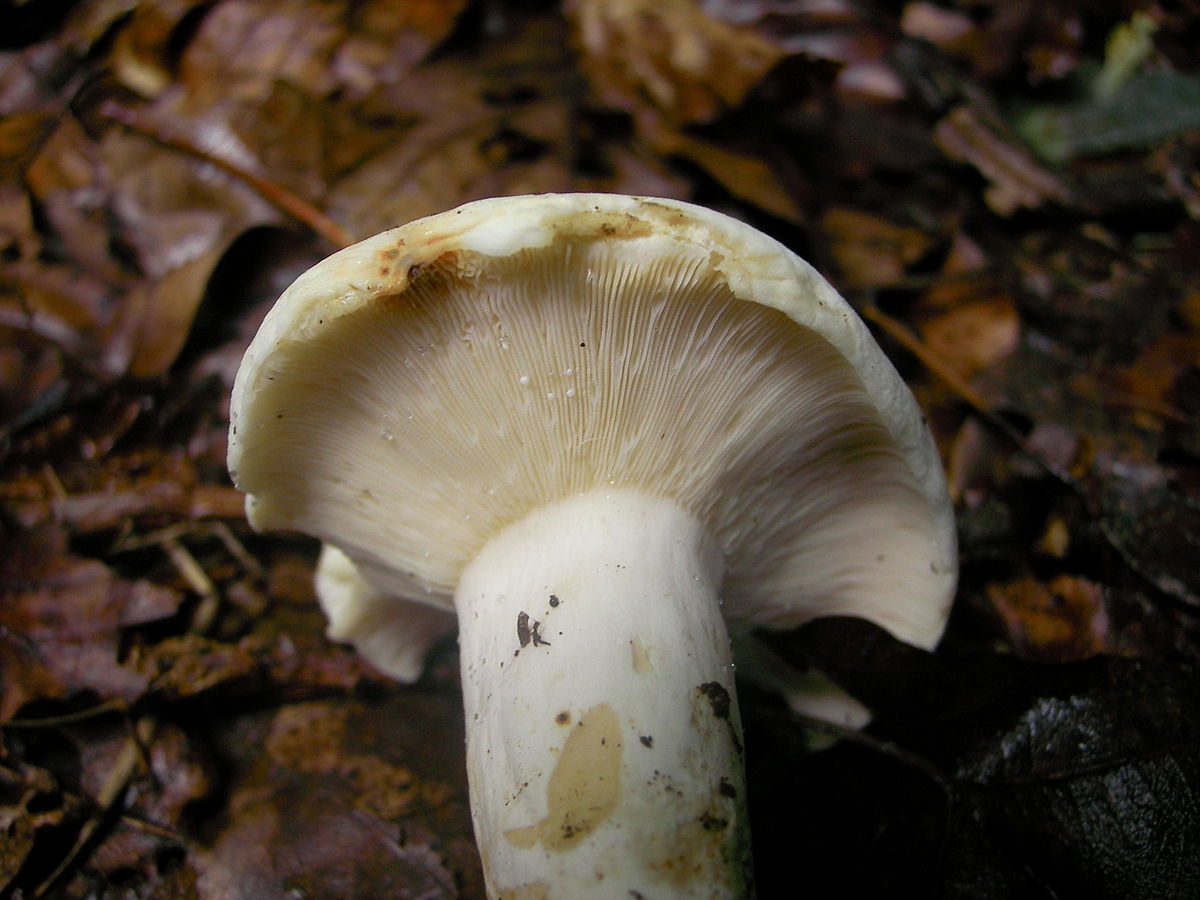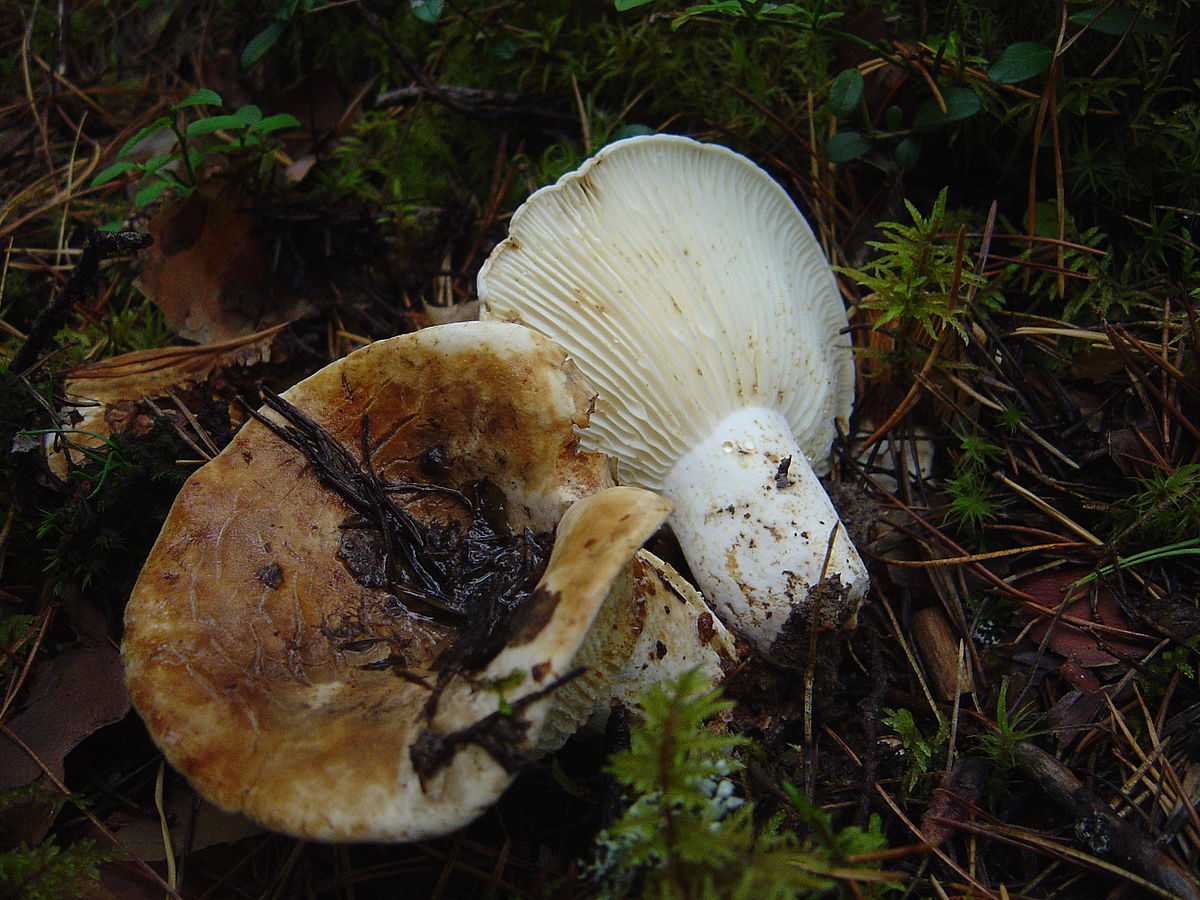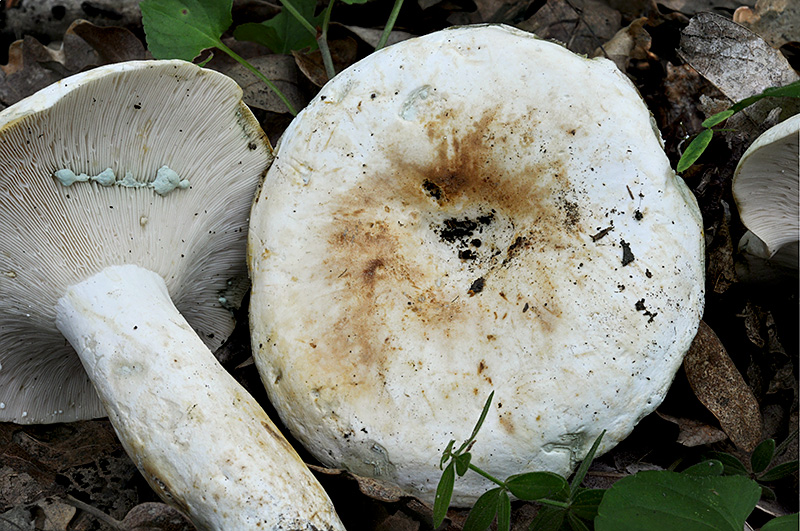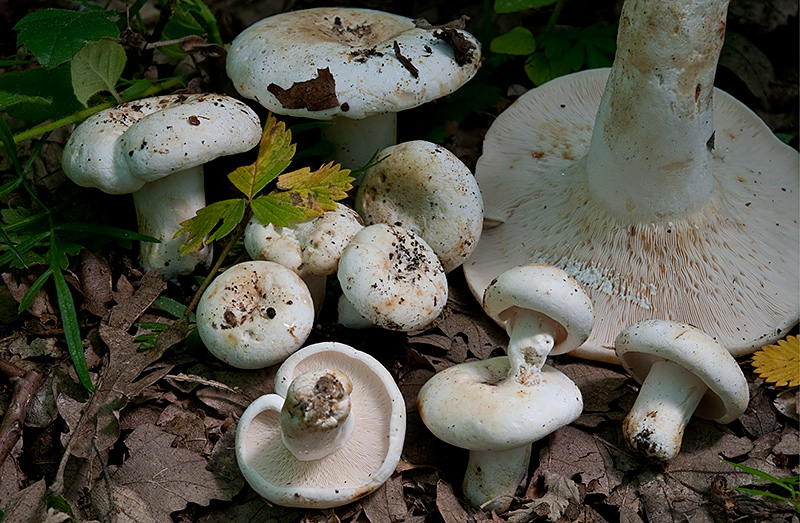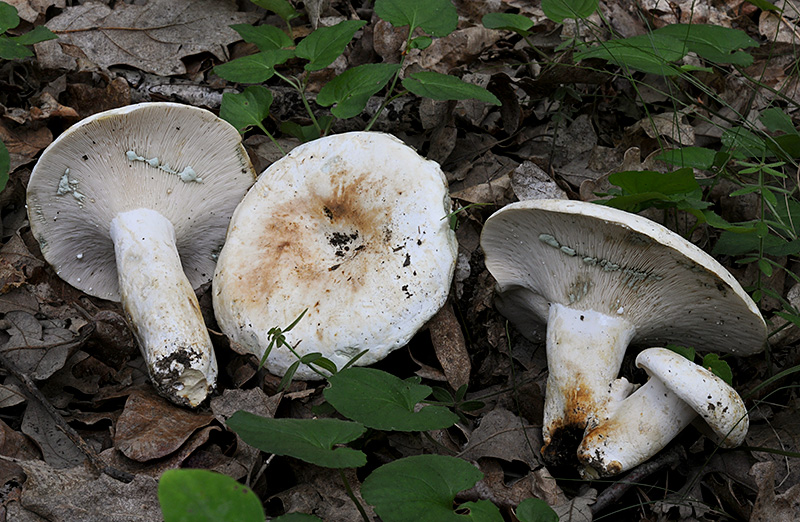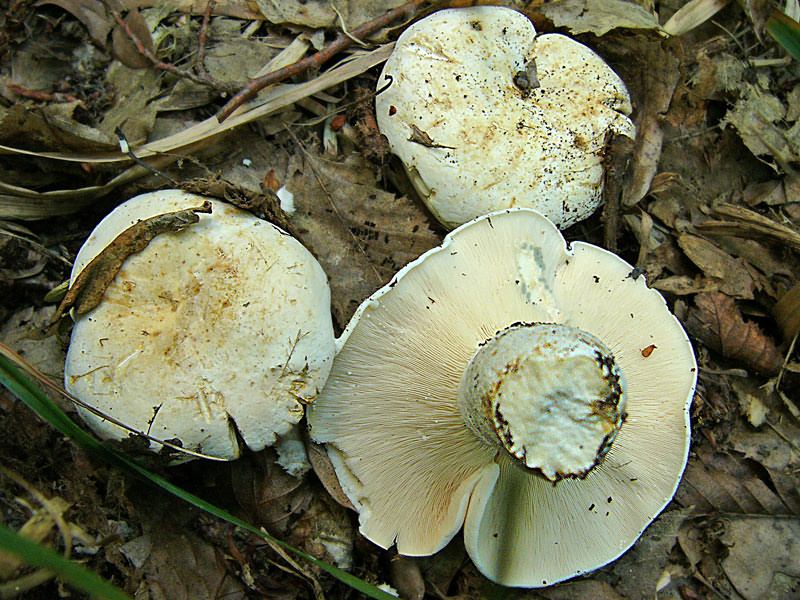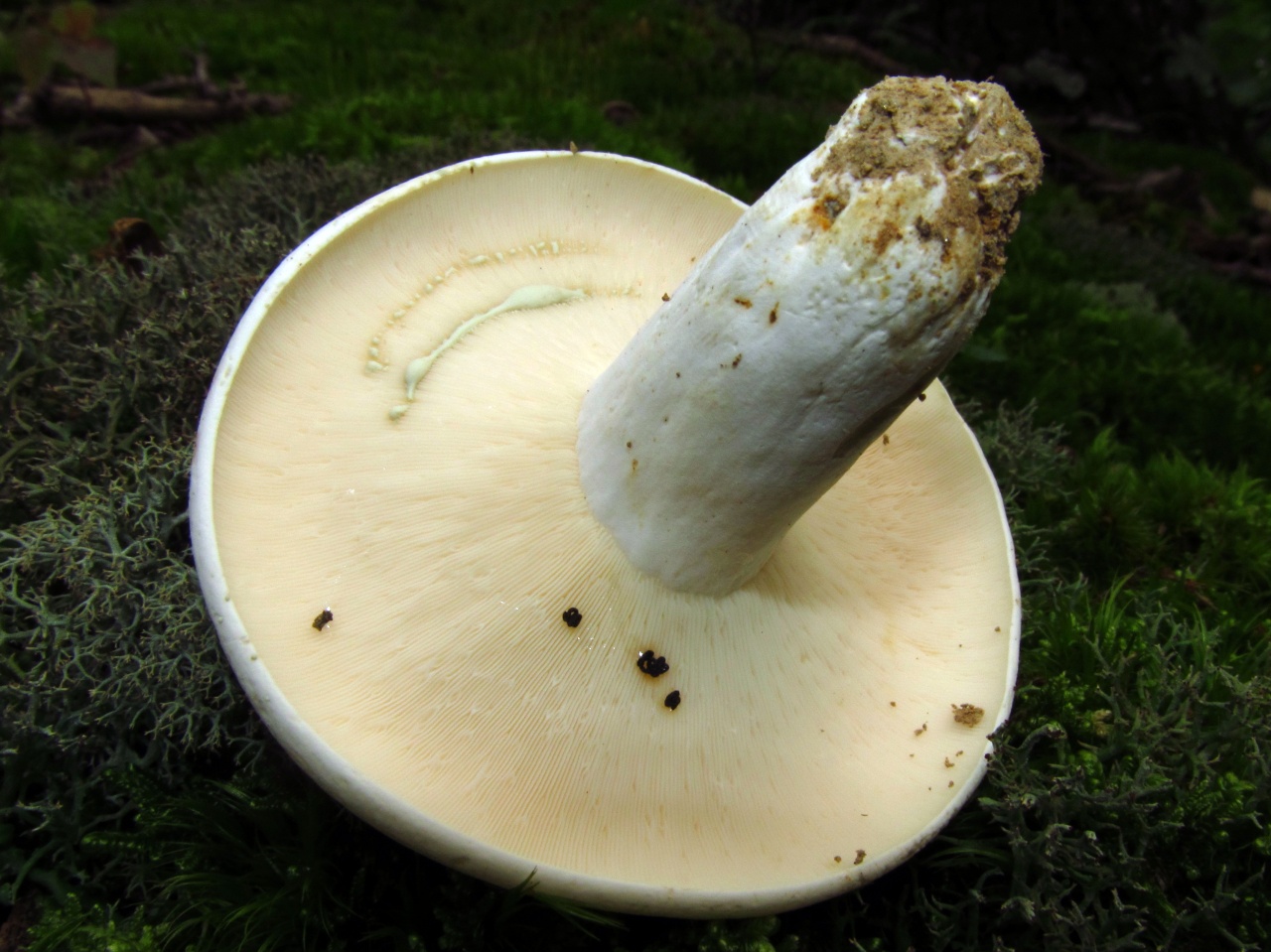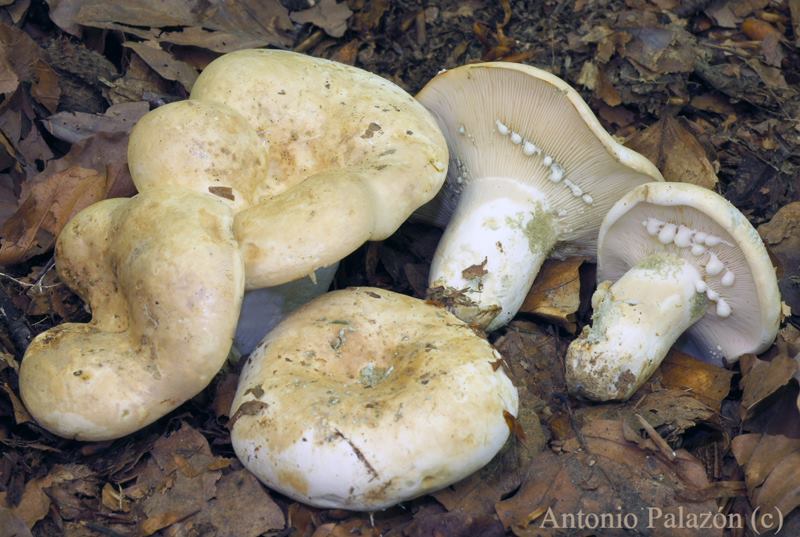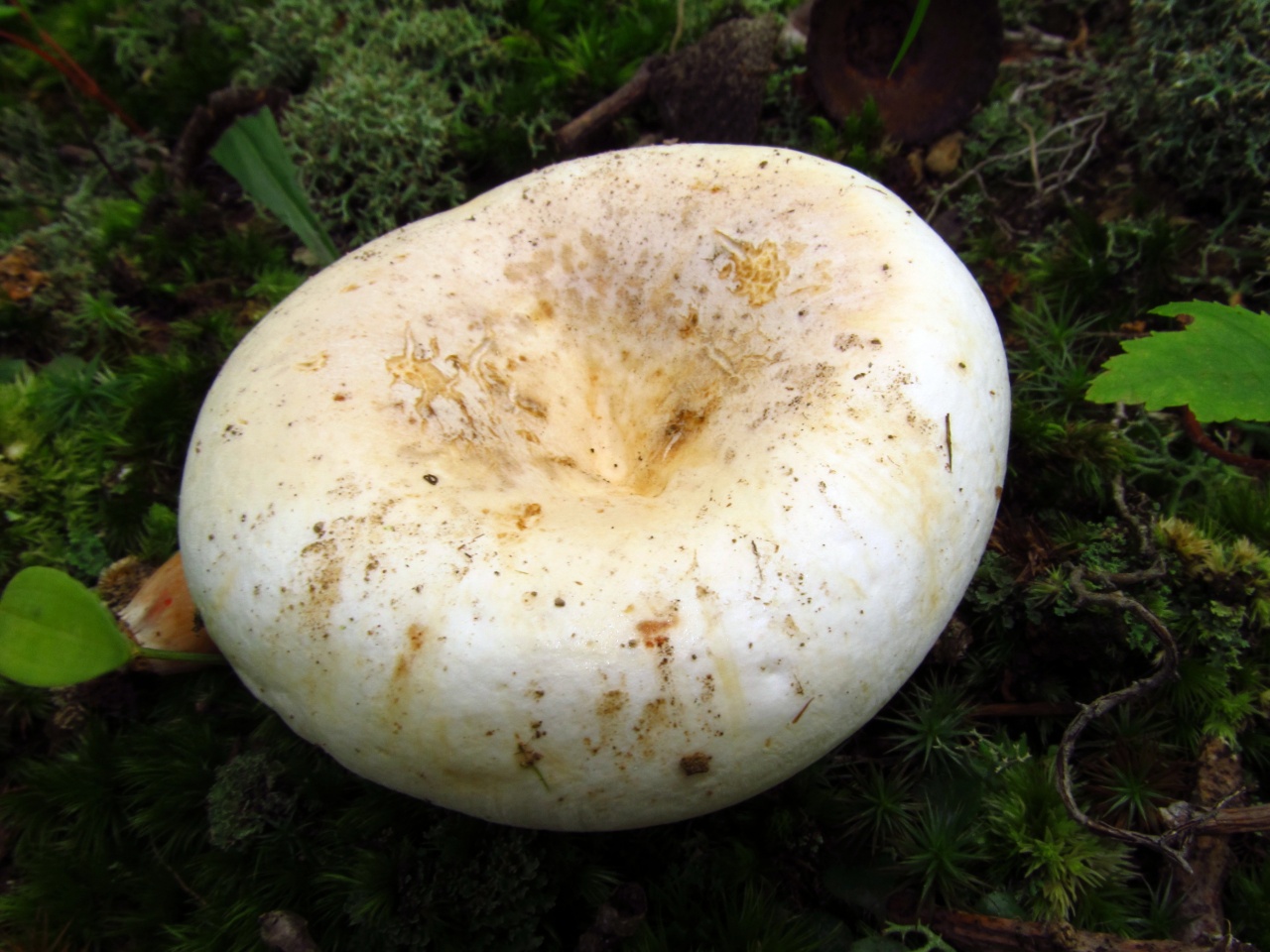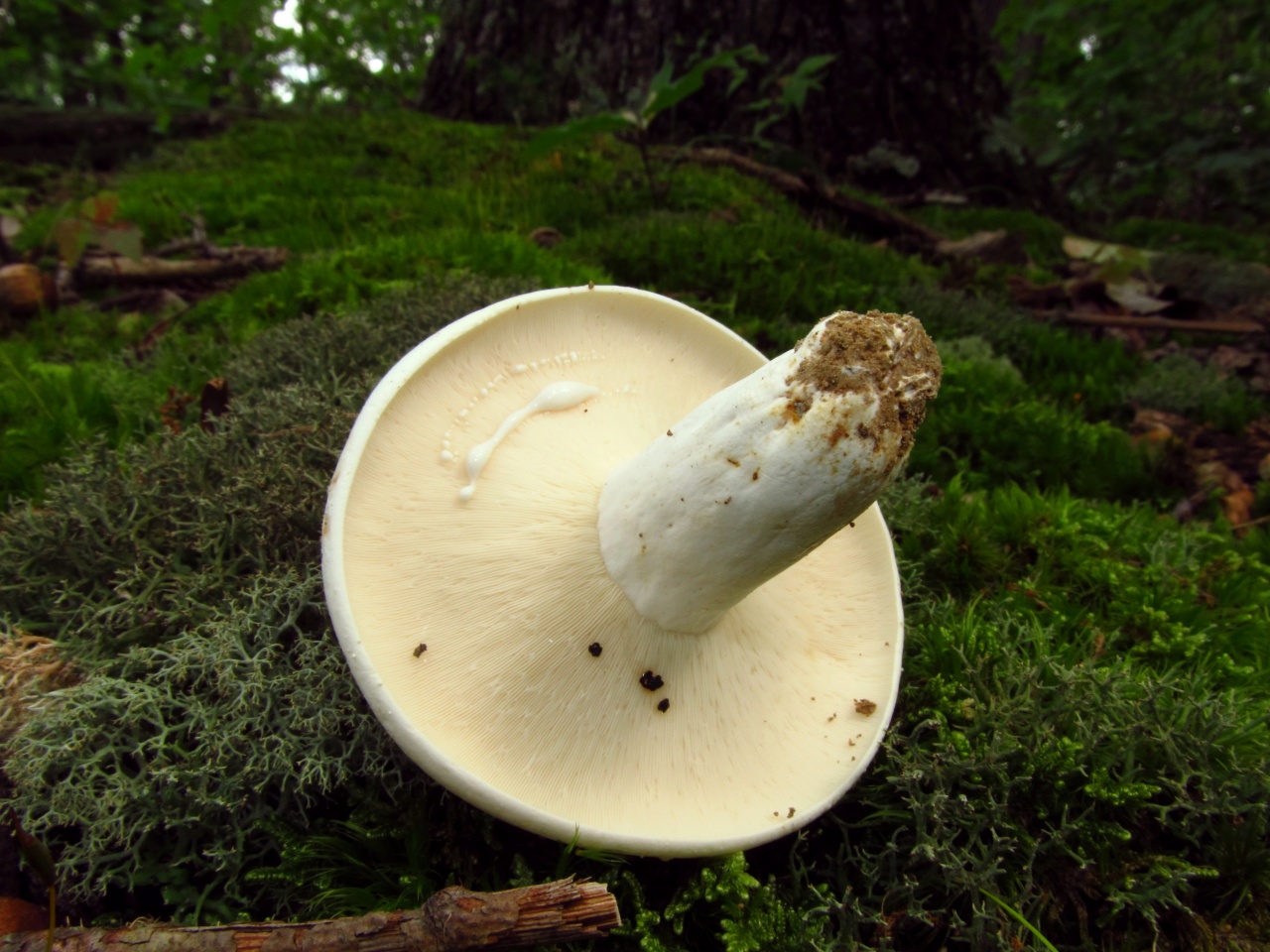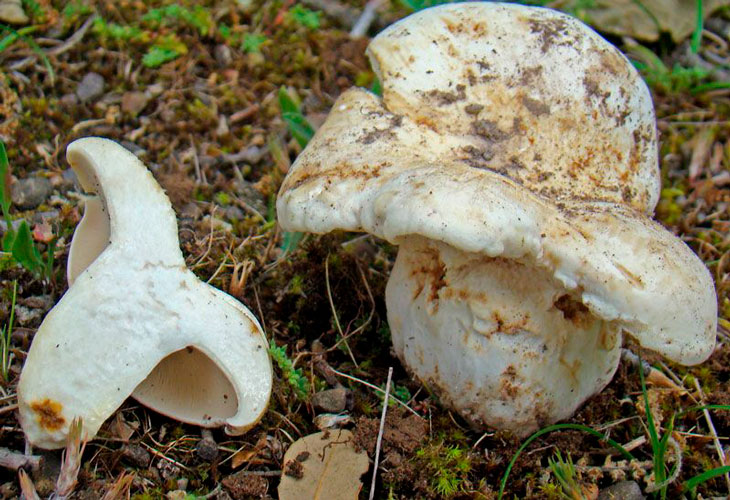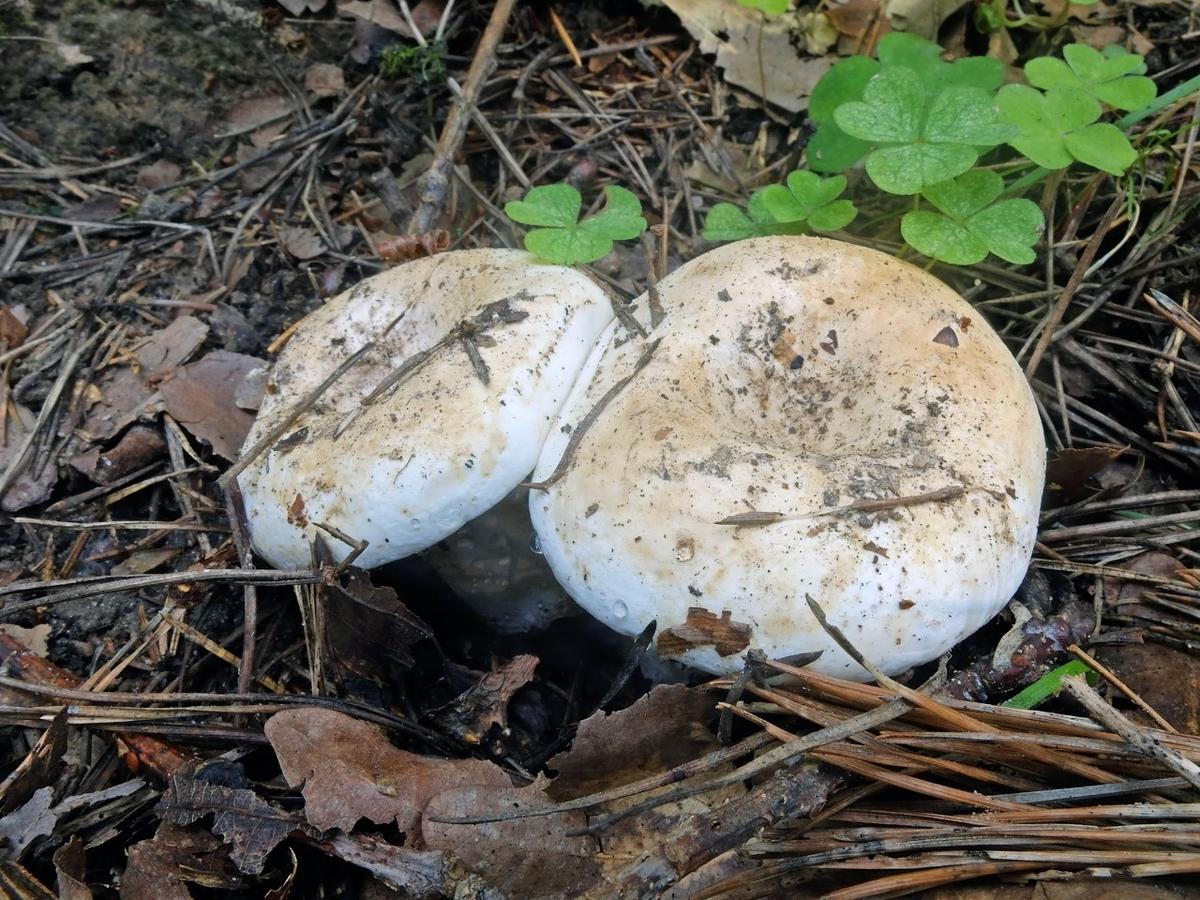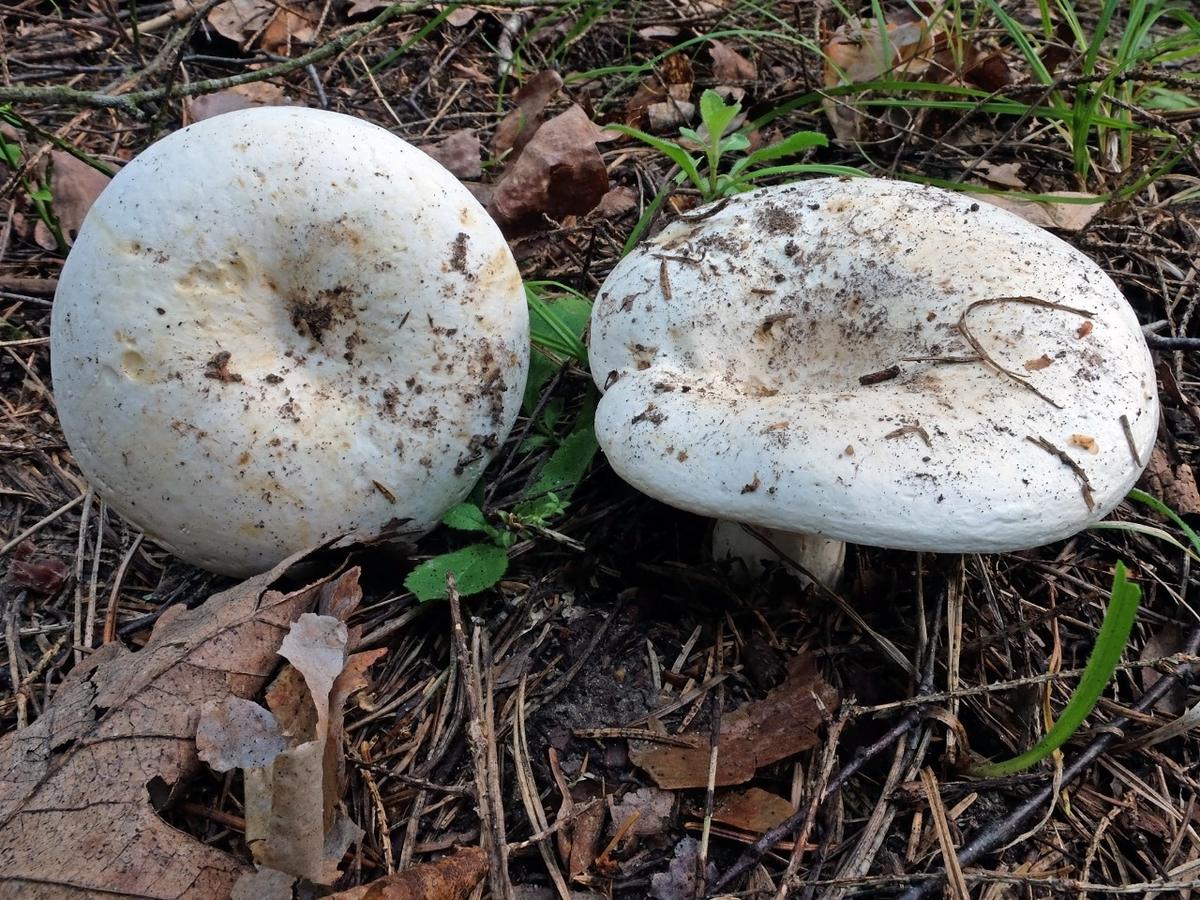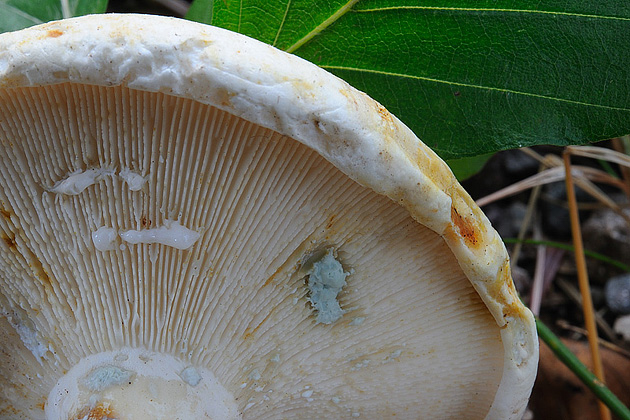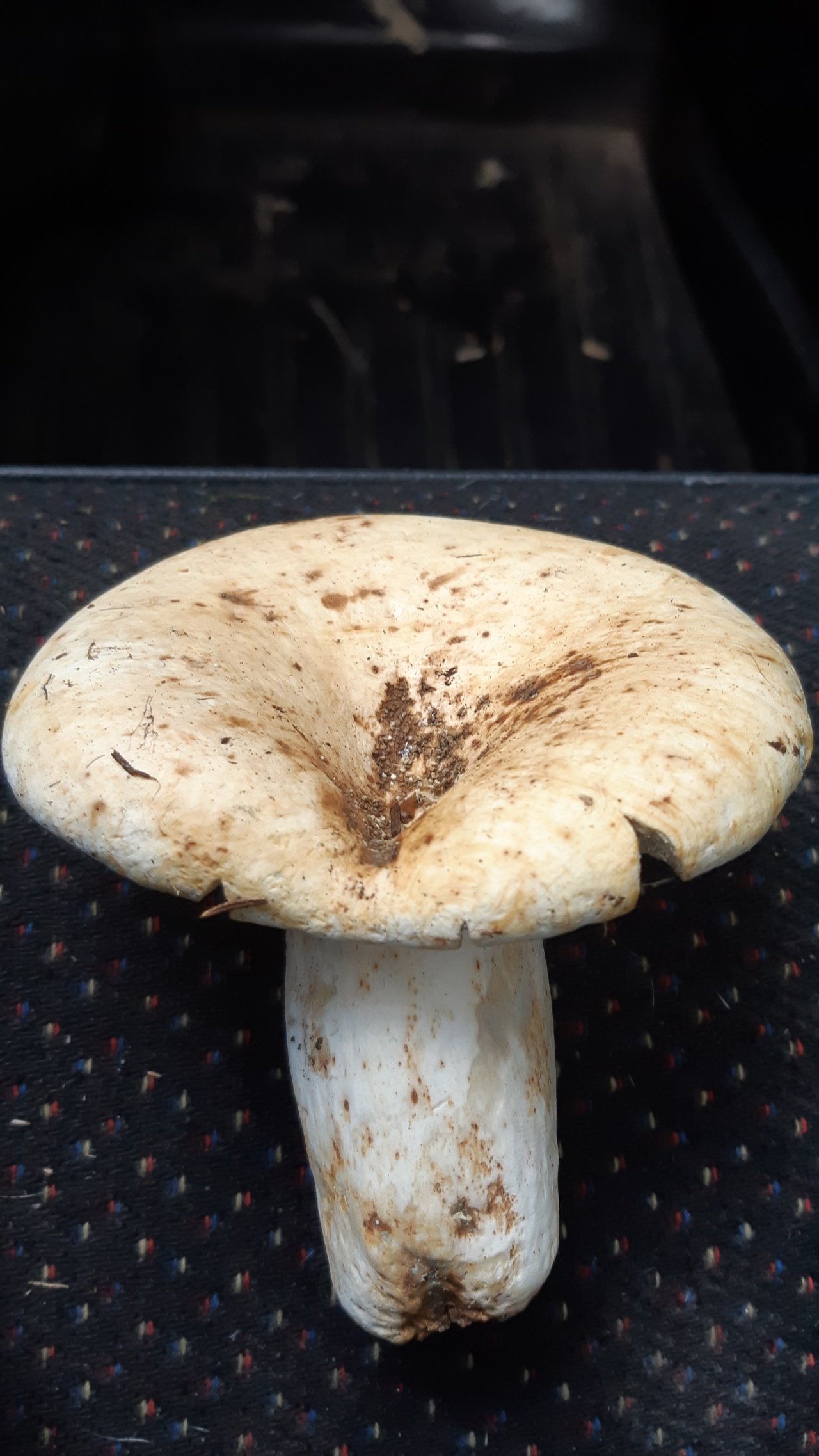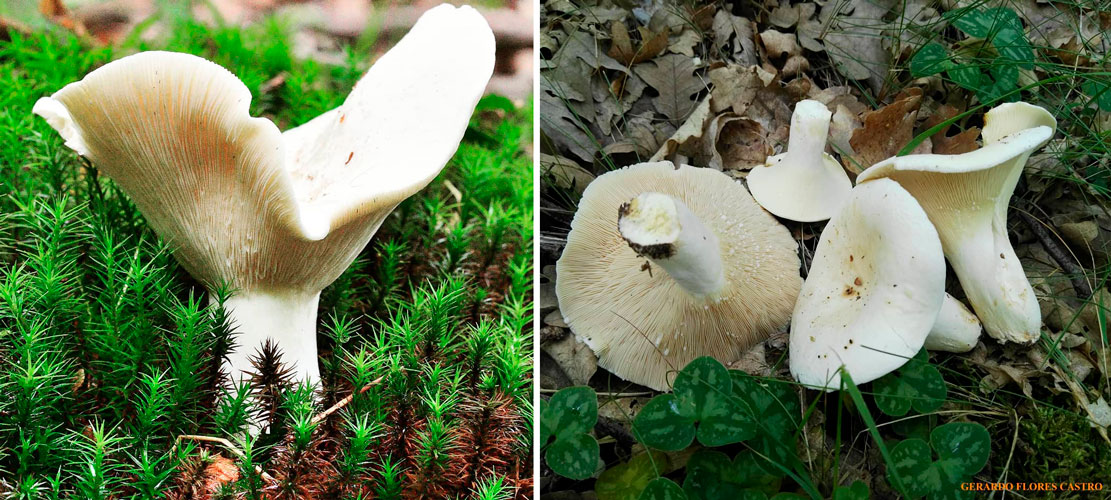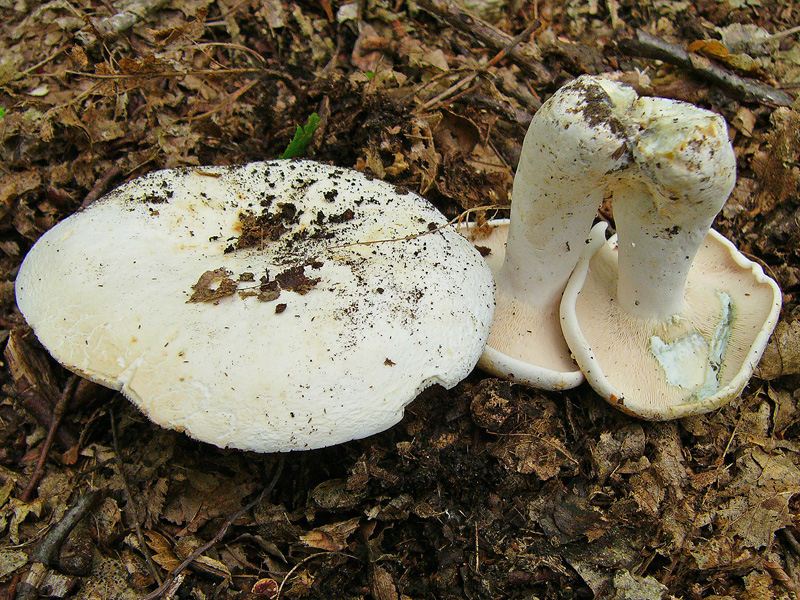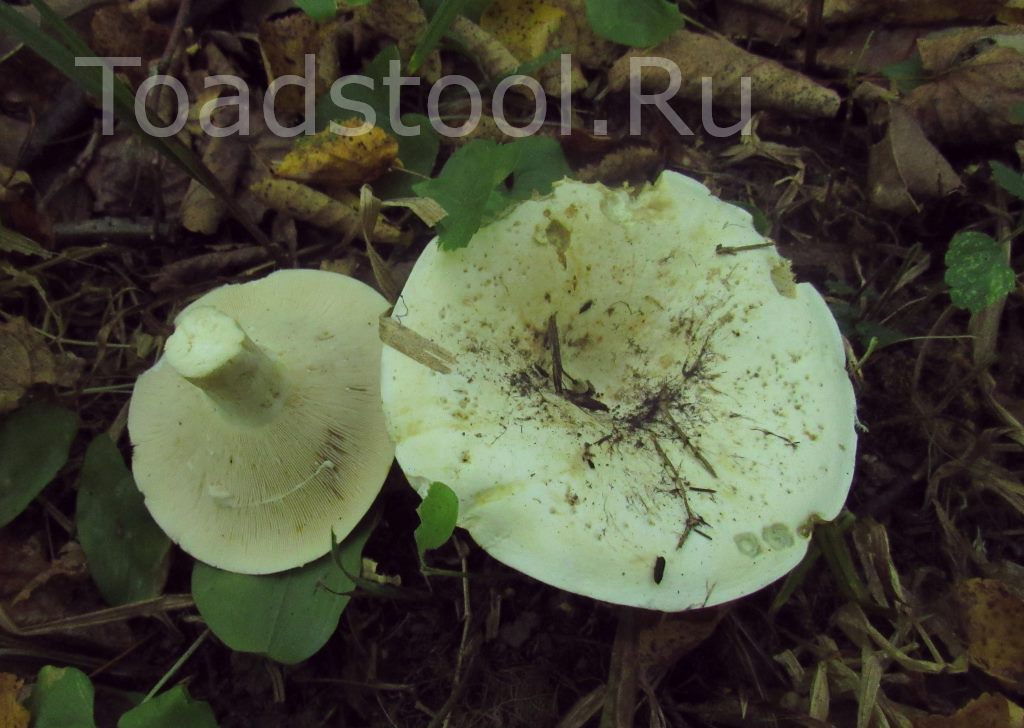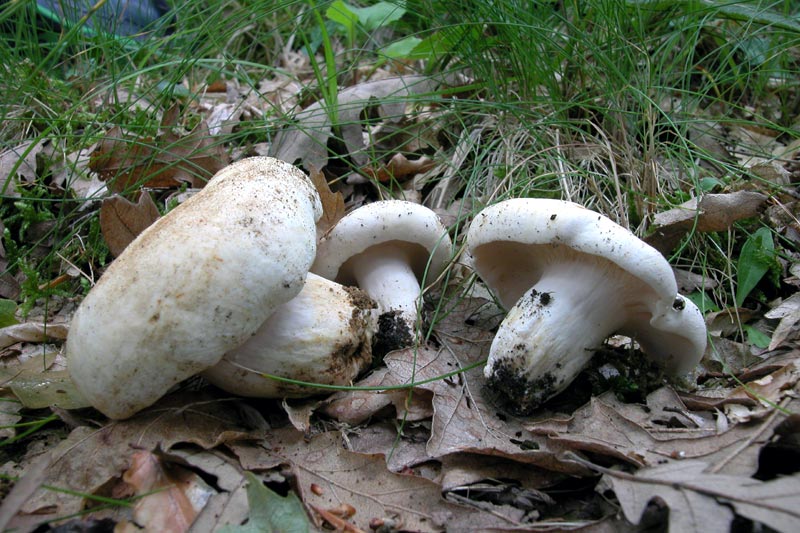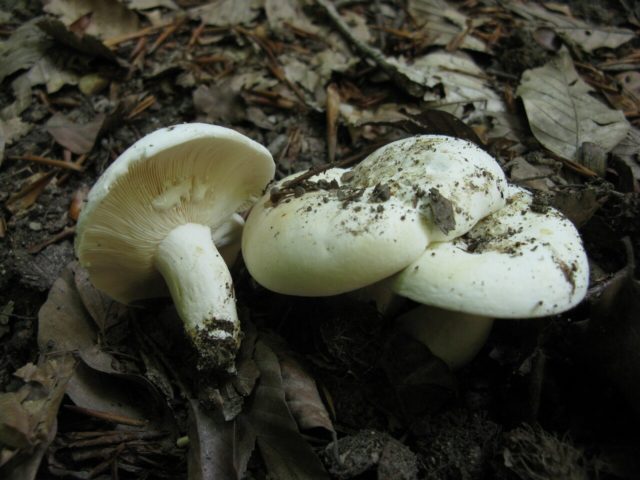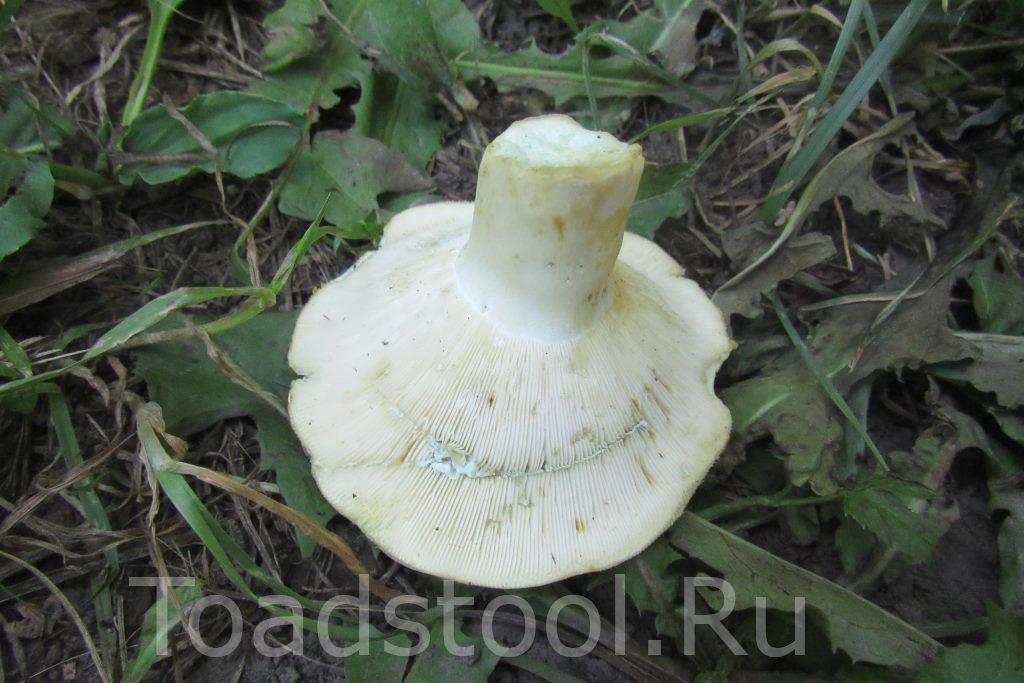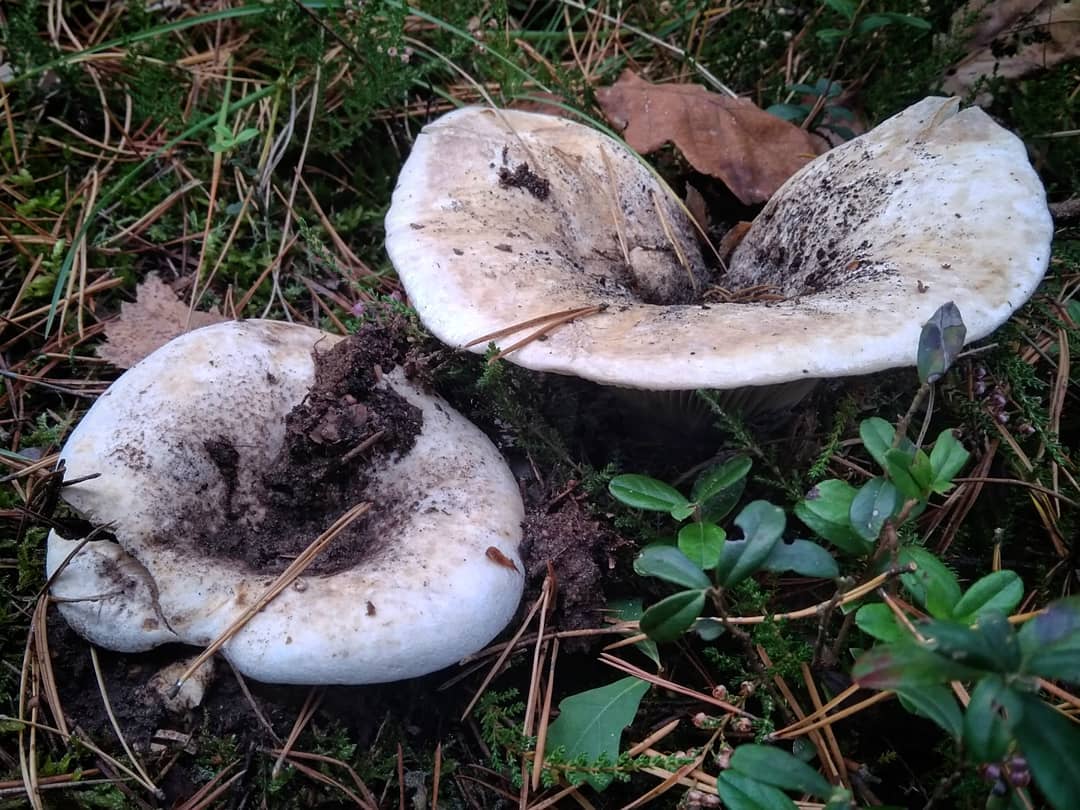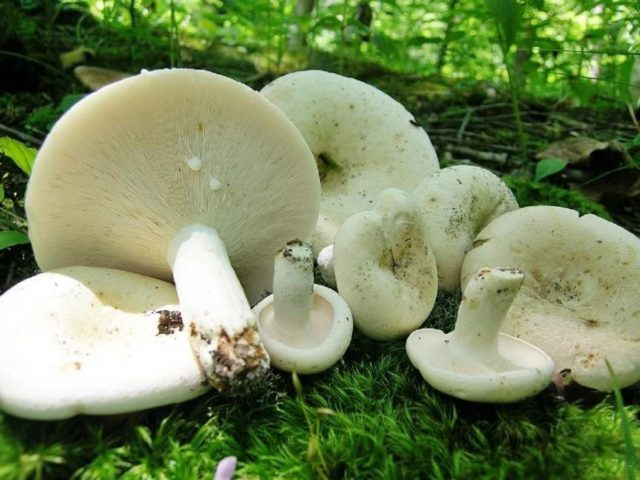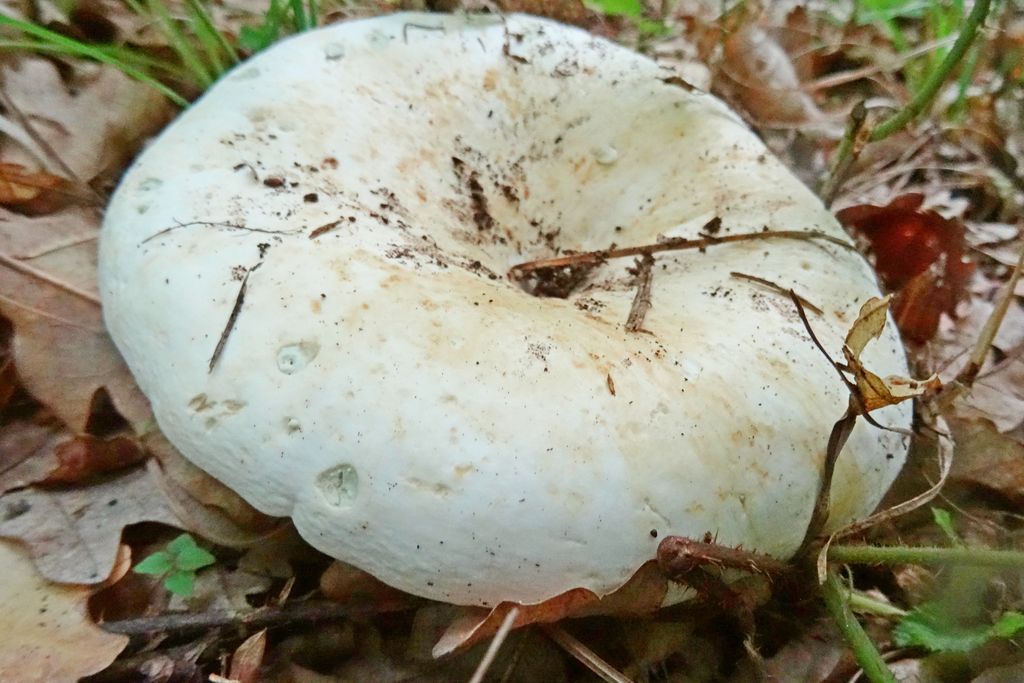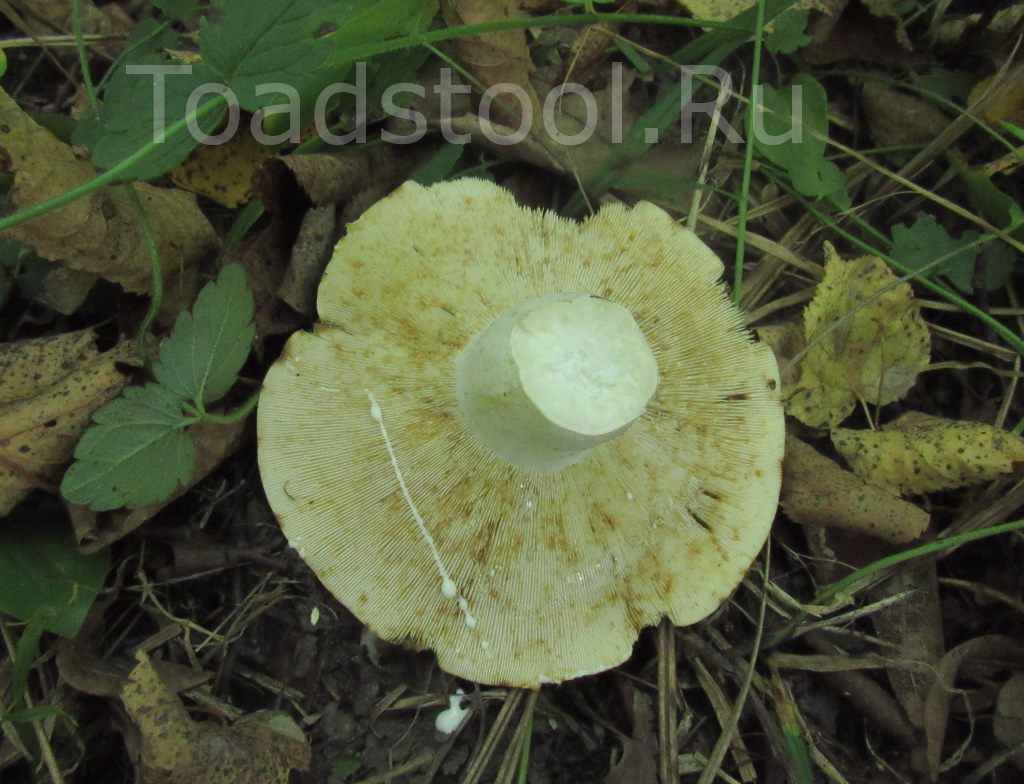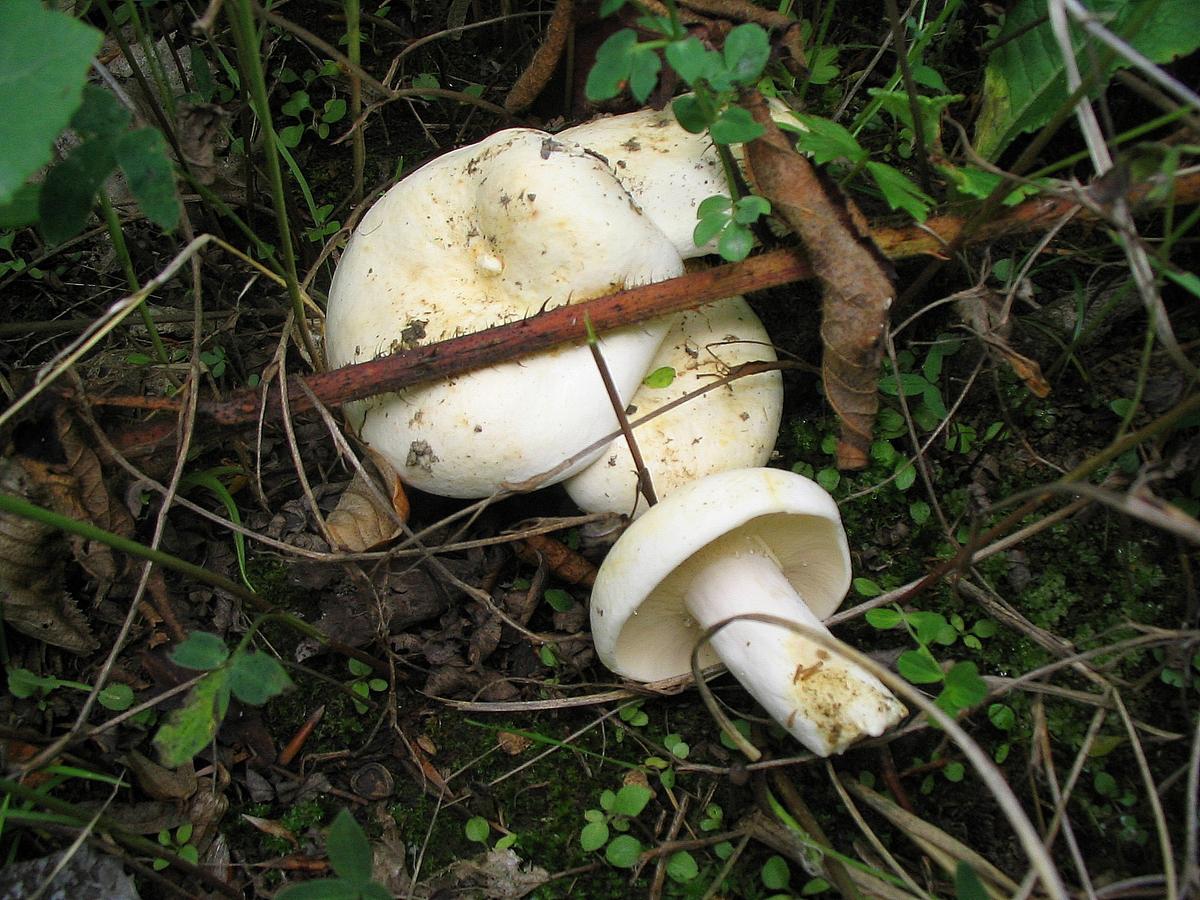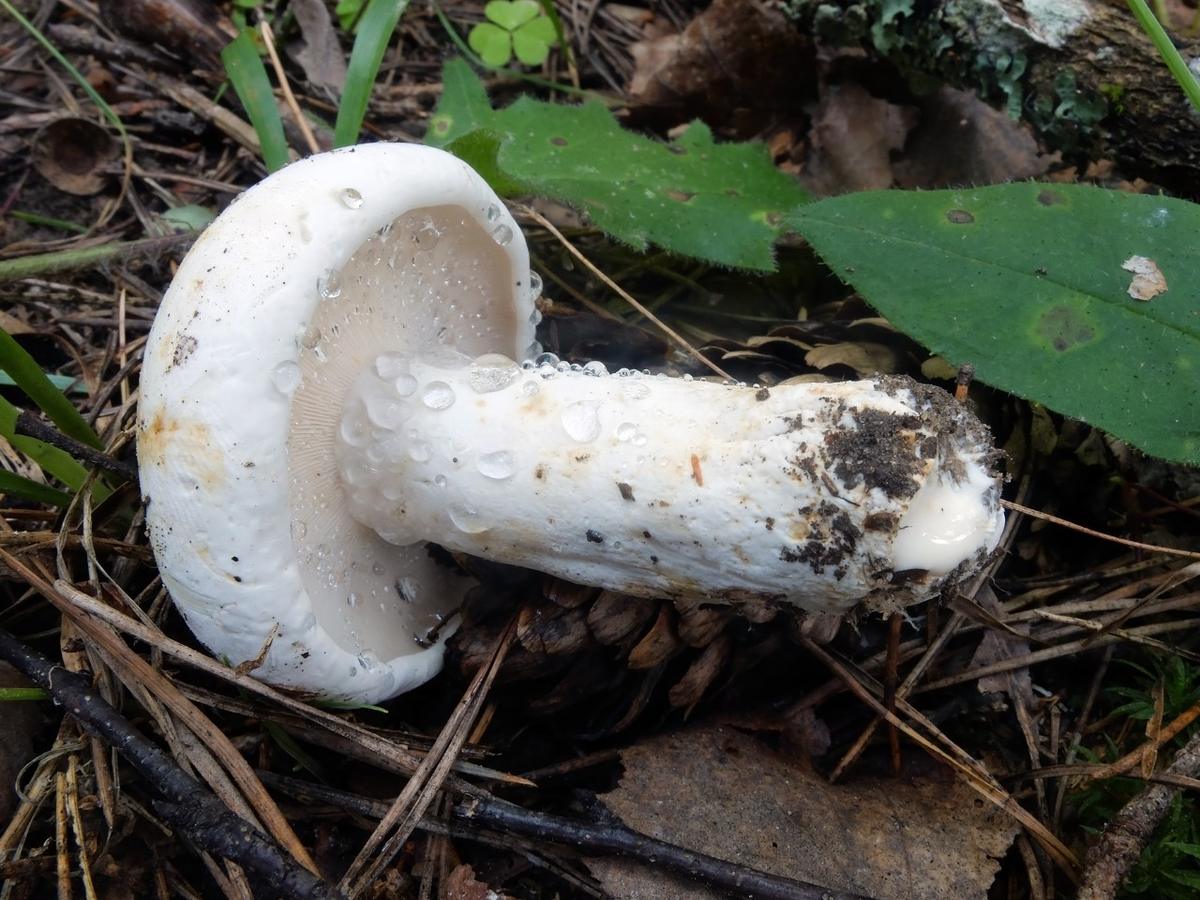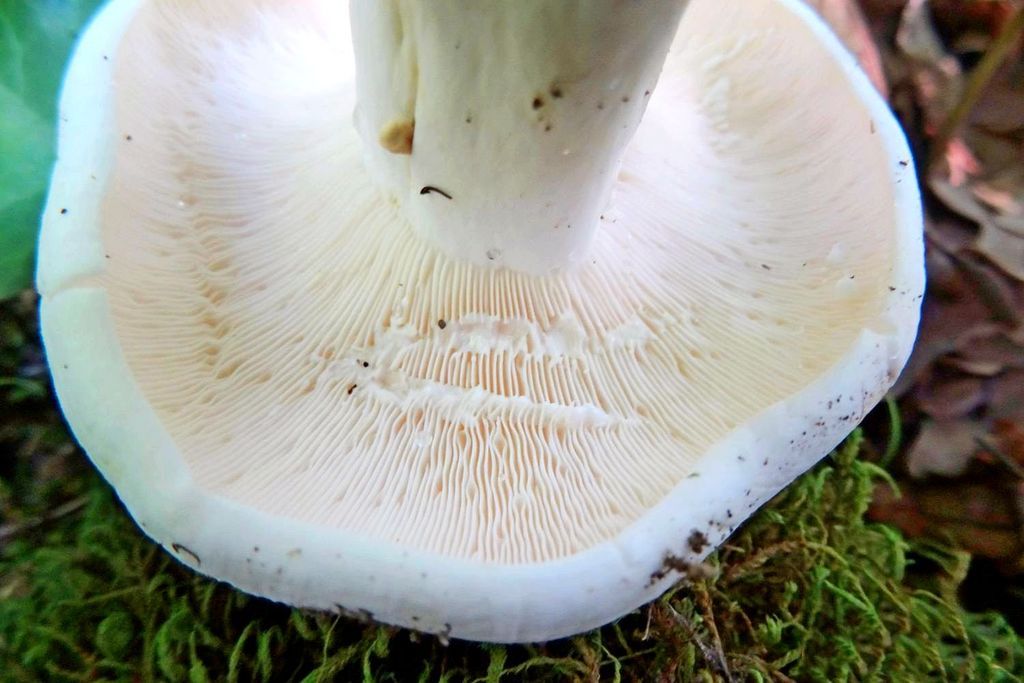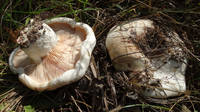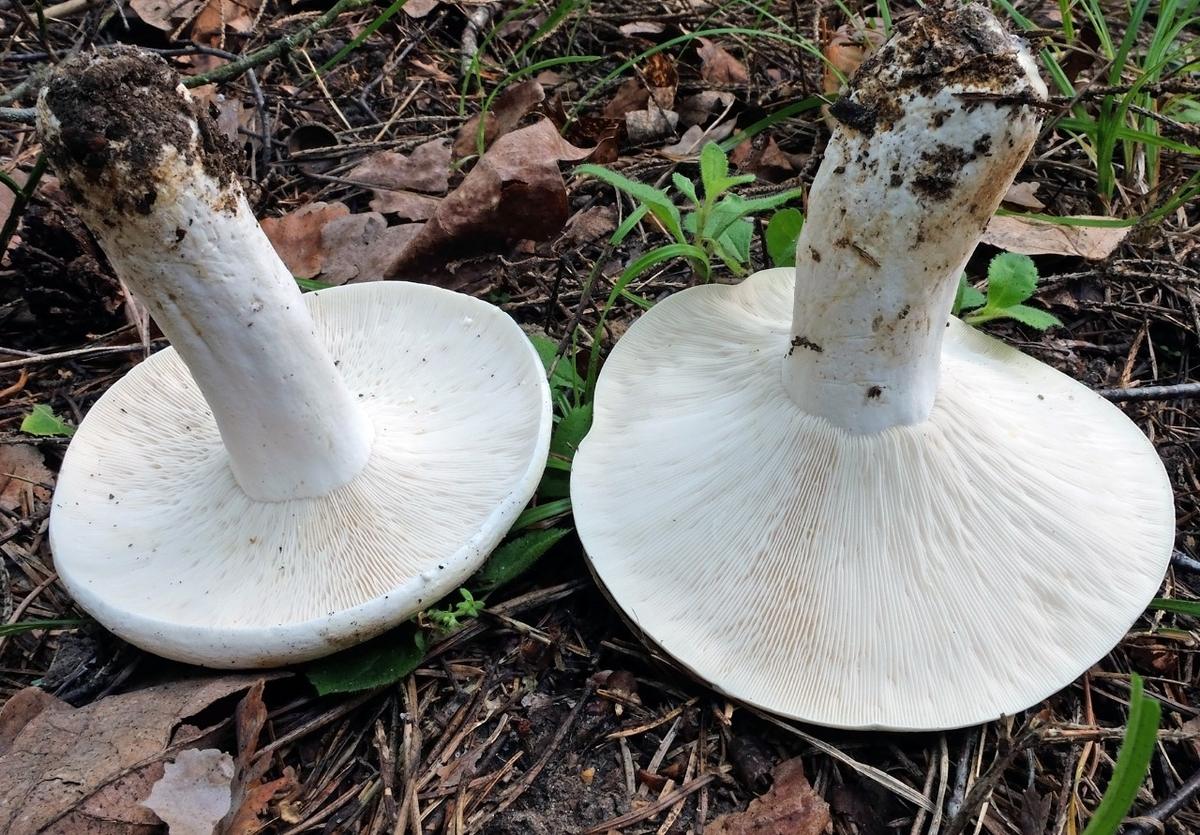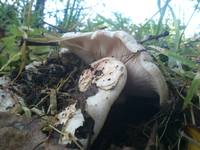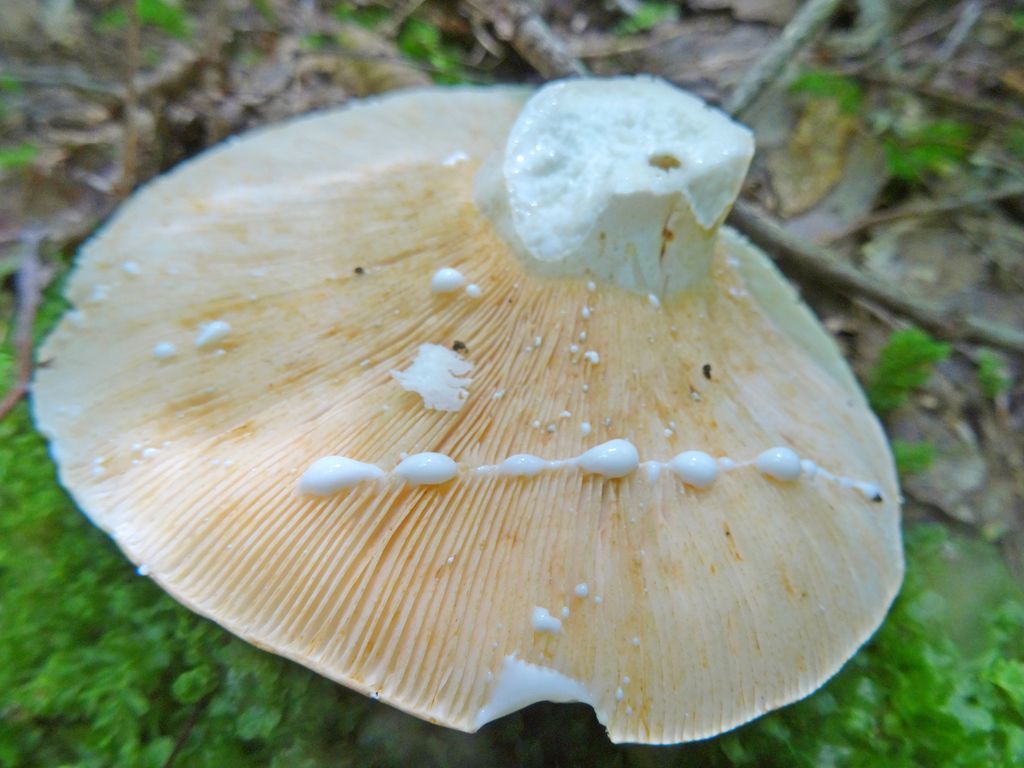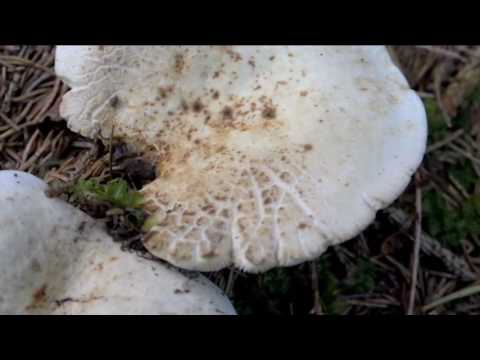Some common doubles
Milk mushrooms and other conditionally edible mushrooms of this family are not poisonous, but not very pleasant for the taste buds. People prepare mushrooms preparatory, then cook. The milk mushrooms are soaked, boiled for a long time with salt.
Pepper milk
The fruiting body of the fungus is creamy white; in mature specimens, the cap is funnel-shaped with many gills. When pressed, bleeds with a whitish milk with a peppery taste. Widely distributed in Europe, the Black Sea region in northeastern Turkey, the eastern part of North America, introduced to Australia. Forms a symbiotic relationship with deciduous trees, including beech and hazel, and grows in soil from summer to early winter.
Mycologists consider it inedible and poisonous; cooks do not recommend it because of its taste. It is difficult to digest when raw. In folk practice, it is used as a seasoning after drying, boiled, fried in butter, pickled, baked in dough.
The mushroom is prized in Russia. People collect pepper mushrooms during the dry season, when other edible mushrooms are less available. In Finland, cooks boil mushrooms many times, drain the water. In the latter, salted chilled water is stored all winter, marinated or served in salads.
Eating fresh and raw mushrooms irritates the lips and tongue, the reaction goes away after an hour.
Milk camphor (camphor milk)
They appreciate it for its smell. Cooks use it as a spice, not for cooking. The size of the camphor lactarius is small to medium, the cap is less than 5 cm in diameter. Color from orange to orange-red and brown shades. The shape of the cap is convex in young specimens, flat and slightly depressed in mature mushrooms.
The fruiting body is fragile and brittle, giving off whitish and watery-looking milk, similar to whey or skim milk. The juice is weak or slightly sweet, but not bitter or pungent. The smell of the mushroom is compared to maple syrup, camphor, curry, fenugreek, burnt sugar. The aroma is weak in fresh samples, becomes strong when the fruiting body dries up.
Dried mushrooms are chopped into powder or insist on hot milk. Some people use L. camphoratus to make smoking mixture.
Violinist (felt load)
It is a fairly large mushroom found next to beech trees. The fruit body is dense, not fibrous, and if damaged, the fungus secretes colostrum. Mature specimens have white to cream-colored caps, funnel-shaped, up to 25 cm across. The wide leg is shorter than the fruiting body. The gills are distant from each other, narrow, with brown spots from dried sap. The spore print is white.
The mushroom is harvested in deciduous forests from late summer to early winter. Milk juice tastes neutral on its own, spicy if consumed with pulp. Felt milk mushrooms in the West are considered inedible because of their pungent taste. In Russia, it is soaked for a long time before cooking, then salted.
Milk golden yellow (golden milky)
Has a pale color, poisonous, grows in symbiosis with oak trees. The cap is 3–8 cm across, with dark markings of coarse rings or stripes. At first, it is convex, but later smoothed out, in older specimens there is a small central depression, lint-free edges.
The whitish or pale yellow stem is hollow, cylindrical or slightly swollen, sometimes pinkish on the lower half. The gills of the hymenophore are frequent, straight, with a pinkish tinge, the spores are white-cream.
The whitish pulp has a pungent taste, colored with abundantly secreted milk. Initially, colostrum is white, after a few seconds it becomes a bright sulfur-yellow.
The golden miller appears in summer and autumn in the northern temperate zones of Europe, North America and North Africa.
Consumption leads to predominantly acute severe gastrointestinal symptoms.
Description and distribution of aspen (poplar)
All milk mushrooms are outwardly similar to each other. Many people know these mushrooms by the saying "called a load - get into the back." But in it, rather, we are talking about a real mushroom - the most valuable conditionally edible mushroom, which has long been intensively collected by mushroom pickers. Other representatives of this genus are less known. One of them is aspen milk mushroom, rather rare and less popular than the real one.
Description
Aspen milk mushroom (Lactarius controversus) is a mushroom of the Russulaceae family, of the Mlechnik genus (Lactarius). In another way, it is called poplar mushroom.
- The cap is fleshy, whitish in color with light pink spots, at a young age it has edges strongly bent downwards and a depressed middle, later it straightens out, becomes widely funnel-shaped. The diameter reaches 7-20 cm. In wet weather, the surface becomes sticky and slimy, which is why it becomes covered with specks.
- On the back of the cap there are cream or light pink plates (an important identifying feature), weakly running down the stem.
- A short, thick leg - 2-7 cm in height and 1.5-4 cm in diameter - has the same color as the cap, or whitish, with yellowish spots. Dense, often narrowed at the base.
- The pulp is white, with a fruity odor and abundant acrid white milky juice, which does not change its color in the air.
The poplar mushroom belongs to conditionally edible - it can be eaten only with preliminary soaking, first of all in salted, less often - in fried and boiled form.
Spreading
Most often, poplar mushrooms can be found under poplars, aspens and willows, since with these trees they form mycorrhiza. They prefer moist warm forests of the temperate zone. In general, these mushrooms are quite rare. In Russia, you can find them in the Lower Volga region from July to October.
Similar species
Often aspen mushroom confused with white or white wolf (Lactarius pubescens). It is quite simple to distinguish between them: the main difference is the pubescence of the cap. It is densely pubescent in the white beetle (“pubescens” means “pubescent”), but not in the poplar mushroom.
It can be distinguished from the real mushroom (Lactarius resimus), a more nutritious mushroom in terms of food, by its pubescence (the real one is pubescent at the edges) and the color of the underside of the cap (the real plate has white, not pink, like poplar).
Other lactarius (representatives of the genus Lactarius), such as the violin (Lactarius vellereus) or pepper milk mushroom (Lactarius piperatus) are also sometimes confused with the aspen milk mushroom, none of them has the underside of the cap painted pink, so it is not difficult to distinguish them.
Primary processing and preparation
As already mentioned, aspen milk mushrooms are conditionally edible, therefore they require special preparation before use. Most often they are salted. The correct cooking technology is very important: if you do not follow it, the mushrooms will be bitter due to the milky juice contained in their pulp.
Before cooking, aspen milk mushrooms should be soaked in cold water, changing it as often as possible to prevent fermentation and souring. The water should cover the whole mushrooms. With frequent water changes, one or two days of soaking is enough. After that, you need to rid the mushrooms of the wormholes, and then boil for 10 minutes. Less commonly, fried aspen milk mushrooms are used.
Nutritional qualities, benefits and harms
100 g contains:
- 1.8 g protein;
- 0.5 g fat;
- 0.8 g of carbohydrates.
Calorie content - 16 kcal.
B vitamins that are contained in many all milkmen, serve as prevention of depression and neurosis. Other substances contained in them are useful for patients with tuberculosis - they neutralize the bacteria that excite it (which, of course, has found application in pharmaceuticals).
Also, milkmen help with kidney failure and urolithiasis, neutralize many toxins and serve as a diuretic.Due to the fact that, with a high nutritional value, they do not contain much glucose, they are often advised to be included in their diet for diabetics.
The poplar mushroom, however, also has a number of harmful properties. Firstly, when using an improperly prepared mushroom, you can get poisoning (this is due to the milky juice contained in its pulp). Secondly, even if the mushroom is cooked correctly, it is rather poorly digested. Therefore, in large quantities, milkmen, like other mushrooms, are not recommended to be consumed. It is especially harmful for those suffering from stomach ulcers, gastritis or other diseases of the digestive system.
As you can see, collecting aspen mushrooms is not devoid of sense: in salted form, they are edible and bring noticeable benefits to the body. They are also very nutritious, so vegetarians can eat them instead of meat.
Significance in human life
According to M.V. Vishnevsky, all species of the genus are edible.
In Europe, the overwhelming number of species of the genus Lactarius considered inedible, or even poisonous. In Russia, many species are considered edible, usually in salted or pickled form.
Some lacticians are used in medicine. From this mushroom (Lactarius deliciosus) and close to it red mushroom (Lactarius sanguifluus) with red milky juice, the antibiotic lactarioviolin was isolated, which suppresses the development of many bacteria, including the causative agent of tuberculosis. Pepper milk (Lactarius piperatus) is used in the treatment of kidney and gallstone diseases, blennorrhea, acute purulent conjunctivitis. Bitter (Lactarius rufus) contains an antibiotic substance that adversely affects a number of bacteria, as well as inhibits the growth of cultures of Staphylococcus aureus [source not specified 1412 days].
Pickled shiitake mushrooms, usually grown in China, are often sold under the name "pickled milk mushrooms" and are also edible.
In philately
As of 2015, at least 114 different postage stamps with images of the milkmen were issued in the world.
Lactarius piperatus on a Moldavian postage stamp (Mi # 694)
Lactarius piperatus on a Romanian postage stamp (Mi # 4290)
- Lactarius blennius - Guinea (Mi # 2523)
- Lactarius camphoratus - Guyana (Mi # 3683), Mauritania (Mi # 1059), Niger (Mi # 1734)
- Lactarius chrysorrheus - Guinea-Bissau (Mi # 3863)
- Lactarius claricolor - Madagascar (Mi # 1632)
- Lactarius deceptivus - Mali (Mi # 1484)
- Lactarius deliciosus - Algeria (Mi # 1013), Angola (Mi # 1421), Bulgaria (Mi # 1267) (Mi # 1275), Botswana (Mi # 318), Guinea (Mi # 762) (Mi # 4255) (Mi # 4681) (Mi # 4741), Guinea-Bissau (Mi # 849), Honduras (Mi # 1845), Spain (Mi # 3143), Cyprus (Mi # 924), Lesotho (Mi # 1317), Liberia (Mi # 4025 ), Mali (Mi # 1480), Mozambique (Mi # 1058), Nicaragua (Mi # 3003), Poland (Mi # 1096), Romania (Mi # 1724) (Mi # 6263), Sao Tome and Principe (Mi # 1631), Saint Vincent and the Grenadines (Mi # 5204), Somalia (Mi # 503), USSR (Mi # 2987), Sierra Leone (Mi # 1078) (Mi # 3723) (Mi # 5215), Togo (Mi # 2355) (Mi # 2818), Turkey (Mi # 3034), Uganda (Mi # 2930), Croatia (Mi # 255), CAR (Mi # 2876)
- Lactarius deterrimus - Afghanistan (Mi # 1845), Norway (Mi # 991), Finland (Mi # 830)
- Lactarius dryadophilus - Greenland (Mi # 465) (Mi # 468)
- Lactarius fulvissimus - Guinea (Mi # 2548) (Mi # 2556)
- Lactarius gymnocarpus - Ivory Coast (Mi # 1194)
- Lactarius helvus - Guinea-Bissau (Mi # 4302), Liberia (Mi # 5240)
- Lactarius hepaticus - Guinea (Mi # 5217)
- Lactarius hygrophoroides - Bhutan (Mi # 2077), Grenadines (Grenada) (Mi # 1447), DPRK (Mi # 3001)
- Lactarius indigo - Guyana (Mi # 6932), Guinea (Mi # 1613), Liberia (Mi # 4026), Mali (Mi # 1485), El Salvador (Mi # 2258), Sierra Leone (Mi # 2573) (Mi # 2579 )
- Lactarius lignyotus - Mali (Mi # 1487), Monaco (Mi # 1864), Switzerland (Mi # 2339)
- Lactarius luculentus - Mali (Mi # 1481)
- Lactarius pandani - Madagascar (Mi # 1314) (Mi # 1541)
- Lactarius peckii - Mali (Mi # 1486), Saint Vincent and the Grenadines (Mi # 5210)
- Lactarius phlebonemus - DRC (Mi # 602) (Mi # 1072)
- Lactarius piperatus - Moldova (Mi # 694), Romania (Mi # 4290)
- Lactarius porninsis - Guinea (Mi # 2529)
- Lactarius pseudomucidus - Mali (Mi # 1482)
- Lactarius putidus - Grenadines (Grenada) (Mi # 774)
- Lactarius resimus - Mongolia (Mi # 1138)
- Lactarius rufus - Nevis (Mi # 1146), Saint Vincent and the Grenadines (Mi # 5211)
- Lactarius romagnesii - Bhutan (Mi # 2078)
- Lactarius salmonicolor - Tanzania (Mi # 3793)
- Lactarius sanguifluus - Andorra (Spanish) (Mi # 167), Guinea (Mi # 2525), Spain (Mi # 3104)
- Lactarius semisanguifluus - CAR (Mi # 4377)
- Lactarius scrobiculatus - Zambia (Mi # 846), Cambodia (Mi # 2064), Mali (Mi # 1483), Mongolia (Mi # 350)
- Lactarius torminosus - Belarus (Mi # 973), Bhutan (Mi # 1152), Guinea-Bissau (Mi # 3861), Comoros (Mi # 1485), Mongolia (Mi # 346), Sao Tome and Principe (Mi # 3005) , Finland (Mi # 864)
- Lactarius trivialis - Montserrat (Mi # 1205), The Grenadines (Grenada) (Mi # 2619)
- Lactarius turpis - Antigua and Barbuda (Mi # 3427), Nevis (Mi # 1142), Sao Tome and Principe (Mi # 3006)
- Lactarius uvidus - Grenada (Mi # 3587)
- Lactarius vellereus - Niger (Mi # 1501)
- Lactarius volemus - Guinea Bissau (Mi # 5651), Grenada (Mi # 3595), Dominica (Mi # 1403), DPRK (Mi # 4221), Sao Tome and Principe (Mi # 1638) (Mi # 2009)
Description and places of distribution of the mushroom peppers, photo
In the forest zone of the middle zone, by the beginning of autumn, various types of milky mushrooms with caustic sap bear fruit abundantly. They have been able to manage them on the territory of Russia for a long time, soaking and salting this crop as a winter harvest. Pepper milk is one of such milkmen.
Description
Pepper milk (Lactarius piperatus) belongs to the class of agaricomycetes, russula family, lactic acid genus.
Has the following distinctive features:
- the cap is white or with a cream shade, with a diameter of 5 to 20 cm. In the center it is covered with reddish spots and cracks. In young specimens, it has a slightly convex shape with tucked edges, later it becomes funnel-shaped, wavy along the edge. The surface is matte, smooth or slightly velvety;
- often located narrow plates are whitish at first, later cream. Descend to the leg, sometimes bifurcate;
- spores are whitish;
- the leg is white and dense, tapering towards the base, up to 8 cm high, up to 4 cm thick, solid, smooth or with slight wrinkles;
- the flesh is brittle, but at the same time dense, white in color. Pepper milk is considered conditionally edible because of the pronounced pungency of the white milky juice, acrid and thick. When in contact with air, it often acquires a greenish-olive or bluish tint.
Spreading
This milky grows both singly and in numerous groups, forming in rows and circles. Prefers sufficiently nutritious loams without moisture stagnation in deciduous, mixed, much less often coniferous forests. Refers to mycorrhizal - growing in symbiosis with tree roots.
Widely distributed in the temperate zone, tends to the northern, cool regions. There, the peppercorn appears in July and bears fruit until the first days of November. In the more southern parts of the range, this mushroom begins to grow a little later, from August.
Similar types and differences from them
Pepper is similar to its related milky mushrooms:
- aspen mushroom (Lactarius controversus). Its characteristic feature is orange-pink plates. The leg is grayish or pinkish in color.
- The violin (Lactarius vellereus), which is distinguished by the pile on the stem and cap, as well as more sparsely spaced plates.
- The parchment lump (Lactarius pergamenus) has a relatively elongated stem and wrinkled cap.
- Glaucous Milk (Lactarius glaucescens). Its description is close to the species characteristics of pepper, but the milky juice of this fungus, initially white, becomes gray-greenish when dried, and turns yellow under the influence of a KOH solution.
Cooking use
According to its taste characteristics, pepper milk is referred to the fourth category of nutritional value. Its preparation includes the obligatory soaking. This procedure will remove the excess pungency of the milky juice. This is followed by salting. A month later, the pepper milk mushrooms prepared in this way are ready for use.
Application
Sometimes these mushrooms are dried, ground into powder, and then used as a hot seasoning, which works as well as selected chili peppers.
In addition, pepper milk mushrooms suppress the development of Koch's bacillus, the causative agent of tuberculosis, and folk healers have long used these mushrooms, frying them, to heal kidney and cholelithiasis.
Since ancient times, milky mushrooms have been able to harvest and use them correctly in the Slavic lands. Pepper milk, which is not known in the West, or is classified as inedible, can also be salted for future use, used as a spicy seasoning, and even used as a medicine.
Glaucous lactus

Lactarius glaucescens
The glaucous milk mushroom belongs to a fairly large family of russula.
It grows in deciduous forests, and sometimes it can also be seen in conifers. It can grow both in open places and in the forest. Prefers calcareous soils.
The fruiting body is represented by a cap and a leg.
The hat in young specimens has a flat shape, with a slightly depressed center. In a later period, it takes the shape of a funnel. The surface is dry, smooth, occasionally velvety. There may be cracks (especially in older mushrooms). The color is white, but more mature mushrooms have cream or ocher spots on the surface.
The glaucous mushroom is a lamellar mushroom, has very narrow plates.Color - cream, ocher-colored spots may appear a little later.
The leg has a length of about 8-9 cm, narrowed at the bottom, differs in density. Some mushrooms may have a hollow stem. The color is also white, but pale yellow spots appear on older specimens.
A characteristic feature of the bluish mushroom is the presence of a very dense pulp, which secretes a specific milky juice at the breaks. The juice is very pungent, pungent; in the air it immediately begins to coagulate, changing the initial white color to a grayish-greenish color. The smell of the pulp is woody, slightly honey.
The glaucous mushroom tolerates dry periods well, while the taste of the pulp also depends on weather conditions.
Lactifluus glaucescens is an edible mushroom, but requires careful pre-treatment (soaking in brine) to prepare it. It is also recommended to add various spices to improve the taste.
They are very similar to the glaucous lump pepper and the parchment lump, but their milky juice does not change color in the open air.
Milk yellow
Milk yellow photo
Systematics. Class - Basidiomycetes, order - Russulales, family russula - Russulaceae, genus Mlechnik - Lactarius.
Milk yellow - Lactarius scrobiculatus... The mushroom is very popular in Russia. The yellow lump has several names, for example: Yellow Voluha, Yellow Podgrud, Pitched Milk, Podskrebysh.
Description of the mushroom yellow lump
Mushroom cap has a cap in diameter of 8-18 cm, can reach 25 cm, dense, fleshy, initially rounded-convex, then more outstretched, funnel-shaped, depressed, shaggy edges, curled down. The surface of the cap is smooth, tomentose-woolly, and in damp weather it is sticky, slimy, straw-yellow or golden, yellow-ocher, very often has dark, imperceptible concentric zones; when pressed, it turns a little brown.
LPs - Descending, anastomosing near the leg (have weak bridges), narrow, thin, frequent, creamy, whitish-gray or white, with age they become yellowish or pinkish, with pressure they turn red.
Leg. The leg of the mushroom is thick, short, 4-6 cm long, and 2-4 cm thick, cylindrical in shape, narrowed at the bottom, the same color as the cap, sometimes a little lighter than it (yellowish-white or slightly brownish), has embossed brown spots ( pits "pockmarks"). In old mushrooms, the leg becomes hollow. The base of the leg may be pubescent.
Pulp mushroom on the cut is white, with age, slightly turns yellow, dense and brittle in consistency, spicy on the palate. Milky sap is thick, plentiful, acrid, white; it turns yellow in the air, however, it may not change color during rainy weather. It has a pleasant smell, some literary sources describe it as fruity.
Disputes. Spore powder of yellowish cream color or light ocher. The spores are short-elliptical, almost spherical - 7.5-9.0 × 6.5-7.5 microns.
Ecology and distribution of the mushroom yellow lump
Habitat. Mushrooms are found, as a rule, in summer and autumn, July-October. Grows in groups in coniferous and mixed forests, sometimes in mountain forests. Often forms mycorrhiza with birch and spruce. Prefers moist places and acidic soils. The yellow mushroom is widespread in the northern temperate zone.
Edible mushroom yellow
Milk is a yellow edible or conditionally edible mushroom of the 1st category. Eat salted or pickled, after removing the bitterness by soaking or boiling. In terms of taste, the real mushroom is not inferior to the mushroom. In Western Europe, it is considered tasteless, because of the bitterness and even a poisonous mushroom. Therefore, these mushrooms are not eaten in Western Europe.
Etymology
The Latin name of the genus in translation means "milk", "giving milk".
The people of the most valuable species, such as Lactarius resimus, have been called mushrooms since ancient times.Currently, many species are called mushrooms, including inedible ones (Lactarius helvus - gray-pink milky); in some reference books, such a name is adopted for most species (except for saffron milk caps and wavelets). "Dry milk mushrooms", or podgrudy (podgruzdami), are not called milkmen, but some types of russula (Russula).
The word "pile" comes from the Proto-Slavic * gruzd, which is related to the word "pile". The assumed internal form of the word in this etymology is "growing on a heap, on a heap." According to another version - from the adjective grudge: "Mushroom mushroom" - "fragile, brittle mushroom" (cf. lit. gruzdùs "fragile, brittle"). Another explanation is “mushrooms growing heavy", That is, in a heap, in large groups.
White and black milk mushrooms: benefits and harms
collage of photos of white and black milk mushrooms in nature
The benefits of milk mushrooms have been known to our ancestors since the time of Russia. In black and white their representatives, it is in many ways similar, namely:
- mushrooms are rich in fiber, protein, vitamins A, B, C, D, riboflavin, thiamine, natural antibiotics,
- harmless for diabetics and people who monitor their body weight,
- treat a lot of diseases - depression, neurosis, tuberculosis, kidney and urinary system diseases, disorders in the nervous system,
- improve the condition of hair and skin.
Their beneficial properties:
- diuretic
- calming
- quickly saturating with a small amount
- regulate blood sugar
- stabilize the digestive tract
- anti-inflammatory
- fortifying
- anti-sclerotic
The harmful effects of milk mushrooms on the human body are mostly associated with:
- the severity of their assimilation,
- frequent use of them for food, optimally - 1-2 times a week for lunch,
- errors in collection, processing, cooking and salting,
- the use of a large number of black milk mushrooms, which absorb an increased rate of carcinogens than their white brothers.
Harm of mushrooms is manifested in:
- food poisoning
- botulism
Are there any false milk mushrooms, poisonous, what do they look like, how to distinguish them from the real ones?
Among the large assortment of edible types of mushrooms, it is the mushrooms that are given one of the first places. There is no mushroom picker who will bypass this mushroom, since it has a rather bright and nutritious taste.
It's a pity, but you can often find false squeaky mushrooms, which have a number of distinctive features. In addition, papillary milk can get into the basket. It can cause quite serious poisoning.
False weight
If you want to understand what kind of appearance such a mushroom has, you need to see the real one live. You also need to get acquainted with the main distinguishing features, compare these features with the appearance of false mushrooms.
- The initial appearance of the cap of an edible mushroom is as follows - the cap is convex, has curled edges. Over time, the cap becomes a different shape. Its edges rise, it turns out the shape of a funnel in the central part.
- The hat of the edible mushroom is moist, quite dense. It can be white or cream in color. As a rule, it is covered with twigs, dirt, mucus.
- Plates of edible mushroom are white, with yellow edges. The edges themselves are wide or rather loose. If you take a false mushroom, then it has dense, hard and thick plates that look unnatural. Often, it is thanks to the plates that you can distinguish a real mushroom from a poisonous one.
- Real milk mushrooms have a large amount of milky juice.
- The edible mushroom has only white flesh.
Milk is a mushroom that has a large number of false twins. But many of these mushrooms are considered conditionally edible, since they are similar in certain characteristics to the real ones.
Lactarius camphoratus
Synonyms: The milk is camphor.
Specifications:
- Info: with milk juice
- Group: lamellar
- Plates: weakly descending
Study history
Genus Lactarius was isolated in 1797 by the Dutch botanist-mycologist Christian Heinrich Person, first under the name Lactaria consisting of six types: L. piperata, L. pallida, L. lateritia, L. torminosa, L. opaca and L. xylophila... In 1799 Person published in his book Observationes Mycologicae information about these species, using the variant as the name of the genus Lactarius... In 1801, the number of species in the genus was, according to Persona, 17, and according to his contemporary, British botanist Samuel Frederick Gray - 12. Both researchers indicated the color of the cap as the main criterion for separating species between themselves.
The Swedish mycologist Elias Magnus Fries, in an 1863 publication, indicates the color and taste of milky sap and the color of the plates as signs that make it possible to distinguish intrageneric groups of species, thus highlighting 3 groups: Dapetes, Piperites and Russulares.
In 1889, the German mycologist Joseph Schroeter proposed an idea (though not further developed) about the division of the genus Lactarius for two: Lactaria and Lactariella based on the color of the spore powder and the microscopic characteristics of the spores.
An important stage in the development of ideas about the genus system was the classification proposed in 1888 by the French mycologist Lucien Kele, based on the nature of the surface of the cap. Kele distinguished three sections: Glutinosi, Pruinosi and Velutini, respectively with a sticky, dry smooth and velvety / hairy cap. This system was later developed in the works of other scientists: A. Rikken, P. Konrad and J. E. Lange.
In subsequent works, the number of intrageneric taxa of different levels increased, mainly due to the systematization of new tropical species. Thus, the French mycologist Roger Aime singled out in the genus Lactarius 3 subgenus: Eulactarius, and Venolactarius and Lactariopsis, including predominantly tropical species.
The German mycologist Walter Neuhoff published a classification of the genus in 1956, where microscopic features of the structure of the pileipellis (cap skin) were first used for division into sections. This feature is one of the main ones today.
Modern ideas about the structure of the genus began to form with the appearance in 1979 of the work of American mycologists Lexemuel Ray Hesler and Alexander Henchett Smith "North American species of Lactarius", where both micro- and macroscopic characters were used to isolate intrageneric taxa. Genus Lactariuswas thus divided into 6 subgenera, 18 sections and 5 subsections.
The last major works devoted to the genus Lactarius are monographs by J. Heilmann-Clausen, A. Verbeken, J. Westerholt “Fungi of Northern Europe. vol. 2: The genus Lactarius, M. T. Basso, Lactarius Pers., R. W. Rainer, British Fungus Flora: Agarics and Boleti. vol. 9 Russulaceae: Lactarius "and A. Bessetta, A. R. Besset, D. B. Harris" Milk mushrooms of North America.
Literature
- "Funghi" - Instituto Geografico De Agostini, Novara, Italia, 1997
- Garibova L. V., Sidorova I. I. Mushrooms. Encyclopedia of the Nature of Russia. - M .: 1999.
- F.V. Fedorov, Mushrooms. - M., Rosagropromizdat
- Gorlenko M. V. et al. Mushrooms of the USSR. - M .: 1980
- Bulakh E.M. Lower plants, mushrooms and bryophytes of the Soviet Far East. Mushrooms.. - L.: Nauka, 1990 .-- T. 1. - S. 13-55. - 407 p. - ISBN 5-02-026578-0.
- Gorovoy L.F. Morphogenesis of lamellar fungi. - Kiev: Naukova Dumka, 1990 .-- 166 p. - ISBN 5-12-000791-0.
- Perova N.V., Gorbunova I.A. Macromycetes of the south of Western Siberia. - Novosibirsk: Publishing house of the SB RAS, 2001 .-- 158 p. - ISBN 5-7692-0460-5.
- Shaporova Ya.A. Russular mushrooms of Belarus: Lactarius and Russula (milky and russula). - Minsk: Belarusian Science, 2007 .-- 275 p. - ISBN 978-985-08-0814-1.
- V. I. Shubin Mycorrhizal fungi of the North-West of the European part of the USSR. (Environmental characteristics). - Petrozavodsk: Karelian branch of the USSR Academy of Sciences, 1988 .-- 216 p.
- Basso M. T. Fungi Europaei. - Alassio, Italia: Massimo Candusso, 1999. - Vol. 7 Lactarius Pers. - 844 p. - ISBN 88-87740-00-3.
- Bessette A., Bessette A. R., Harris D. B. Milk Mushrooms of North America. - Syracuse, USA: Syracuse University Press, 2009 .-- 299 p. - ISBN 0-8156-3229-0.
- Funga Nordica / Editors Knudsen H., Vesterholt J .. - Copenhagen, Denmark: Nordsvamp, 2008 .-- 965 p. - ISBN 978-87-983961-3-0.
- Heilmann-Clausen J., Verbeken A., Vesterholt J. Fungi of Northern Europe. - Odense, Denmark: Skive Offset, 1998. - Vol. 2: The genus Lactarius. - 288 p. - ISBN 87-983581-4-6.
- Kränzlin F. Fungi of Switzerland. - Luzern, Switzerland: Verlag Mykologia, 2005. - Vol. 6 Russulaceae. - 318 p. - ISBN 3-85604-260-1.
- Rayner R. W. British fungus flora. Agarics and Boleti. - Oxford, UK: Alden Press LTD, 2005. - Vol. 9 / Russulaceae: Lactarius. - 318 p. - ISBN 1-872291-34-1.
What a real mushroom looks like (white): photo and description
Category: edible.
Other names: white milk mushroom, raw milk mushroom, pravian milk mushroom, wet milk mushroom.
Since the beginning of the XIX century. in Russian scientific circles, the real milk mushroom was called the pepper milk - Lactarius piperatus. But in 1942 the scientist-mycologist Boris Vasilkov proved that the people consider the species Lactarius resimus to be the real one.
Above you can see what the white lump looks like in the photo. Its cap (diameter 6-25 cm) is white or yellowish. In young mushrooms, it is flat, but over time acquires the shape of a funnel. On the edges bent towards the inner side, there is almost always a noticeable fluff. It is sticky and very wet to the touch.
If you look closely at photo of a real lump, on its cap you can almost always see plant debris, which sticks to the milk mushrooms more often than other mushrooms.
Leg (height 3-9 cm): white or yellowish, cylindrical, hollow.
In the photo of a real weight, frequent plates of white or yellowish color are clearly visible.
Flesh: white with white milky juice, which, when exposed to air, turns dirty yellow or grayish. The smell is similar to that of fresh fruit.
Doubles: white podgruzdok (Russula delica), the main difference of which is the absence of milky juice in the latter. The violin case (Lactarius vellereus) also looks like a white lump, only its hat is more “felt” and there is no cannon. White boll (Lactarius pubescens) is much smaller in weight and with a more pubescent cap. Aspen milk mushroom (Lactarius controversus) grows under aspen trees, where real milk mushrooms are practically not found. And the milky juice of peppercorns (Lactarius piperatus) turns green when it interacts with air.
The white mushroom grows from the beginning of July to the end of September in the Volga region, Siberia and the Urals.
Where to find it: In deciduous and mixed forests near birches.
Eating: salted after a long boil to remove bitterness. Under the influence of brine, juicy and fleshy real milk mushrooms acquire a bluish tint, and after 40 days you can already enjoy their taste. In Siberia, according to tradition, real milk mushrooms are still salted along with volushki and mushrooms. During the famous meal, arranged in 1699 by the Archbishop of Moscow and All Russia Andrian, guests were served, in addition to other dishes, “three long pies with mushrooms, two pies with milk mushrooms, cold mushrooms with horseradish, cold milk mushrooms with butter, milk mushrooms heated with juice, yes oil ... ". In Western Europe, a real mushroom is considered an inedible mushroom, and in Russia it has long been called the king of mushrooms. A real milk mushroom surpasses even fatty meat in calorie content: in dry matter, the protein content reaches 35%.
Application in traditional medicine (data have not been confirmed and have not undergone clinical trials!): In the treatment of renal failure and urolithiasis.


